Ep. 63: All My Darling Daughters, by Fumi Yoshinaga
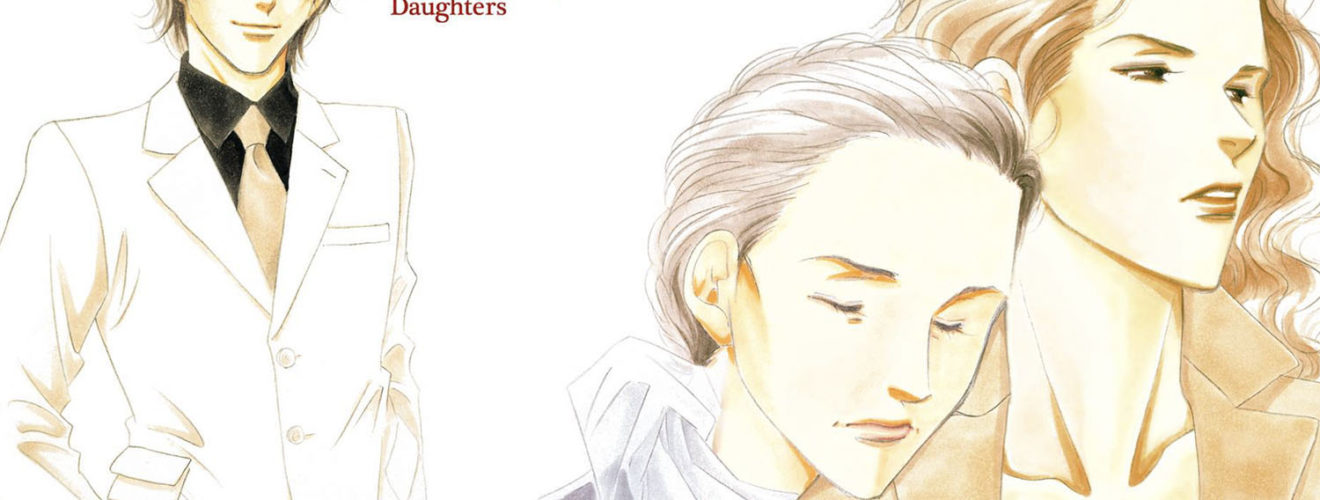
This week, we dive back into a josei title, and it’s by a noted boys love manga creator! It’s all coming together in this week’s All My Darling Daughters by Fumi Yoshinaga! But does this manga from the dark days of 2003 hold up to the rigors of life in 2022? Will Chip and the gang ‘vibe’ with what Yoshinaga is ‘laying down’? Only one way to find out groovy people: get hip to this episode of Mangasplaining.
Powered by RedCircle
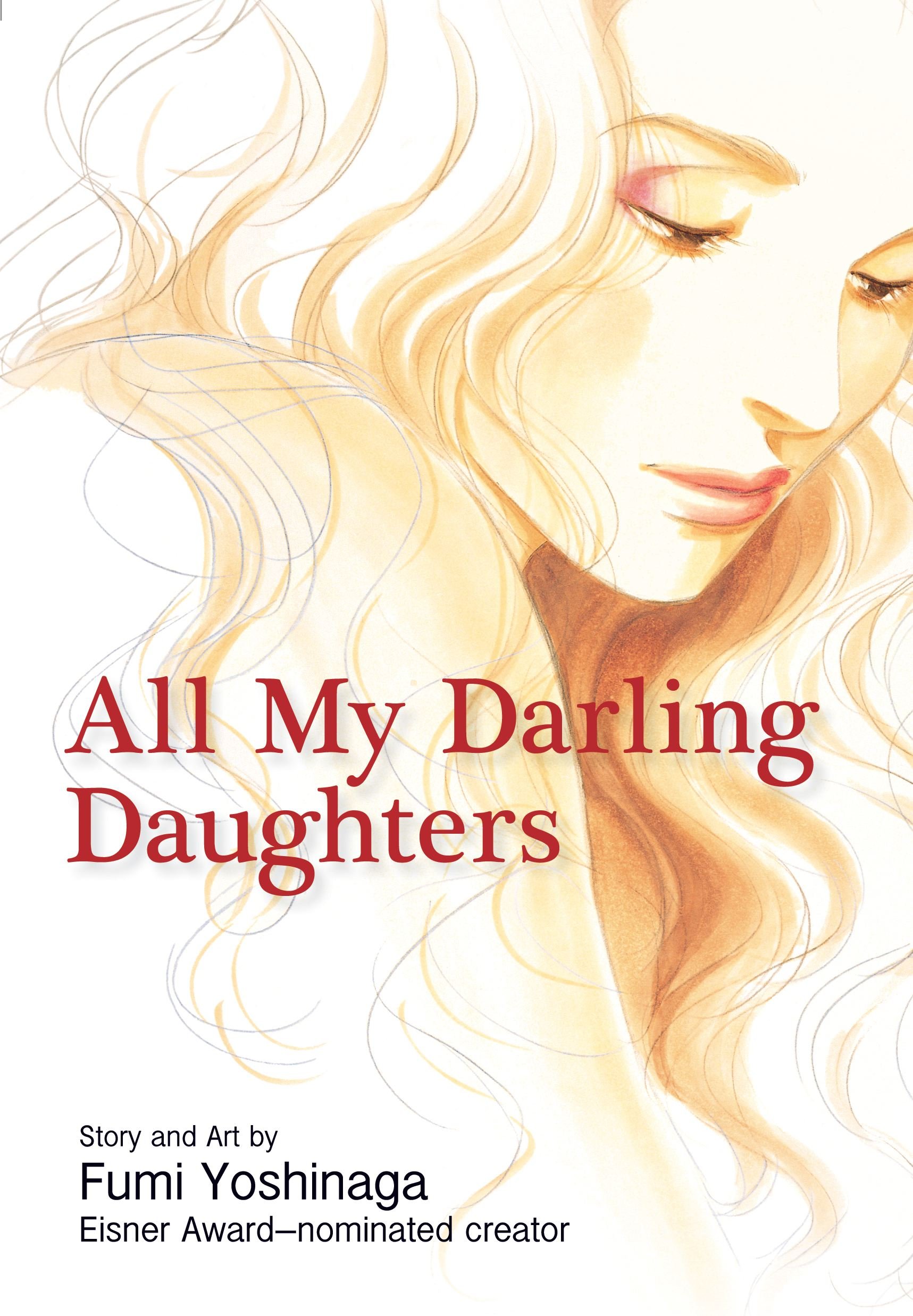
All My Darling Daughters
By Fumi Yoshinaga
Translation and adaptation by John Werry
Touch-up art and lettering by Evan Waldinger
Published by VIZ Media in 2010 (Print/Digital)
Show notes by Christopher Woodrow-Butcher and Deb Aoki. Audio editing by David Brothers.
Before We Get Started:
This week I (hey, it’s Christopher) was on the road with my just-ok headset microphone, in a room with a lot of hard surfaces. So uh, sorry I’m a bit echo-y!
Also, we bounce around a LOT this episode. This is a really fun one (with some heavy moments too), but we talk a lot about the various short-stories in this one and bounce back and forth and all over the place. If you haven’t read the book it miiiiight be a little bit hard to follow this week. Our apologies!
Finally: SPOILERS. Seriously, we spoil the whole thing.
00:00 Let’s talk a little bit about Fumi Yoshinaga:
Born in 1971 in Tokyo, Fumi Yoshinaga is a Tokyo-based cartoonist who has taken home more-or-less every major Japanese comics prize, including the Tezuka Osamu Cultural Prize, the Kodansha Manga Award, the Shogakukan Manga Award, the Japan Media Arts Festival Excellence Prize, The James Tiptree Jr. Award, and many more besides!
[Deb:] She was also nominated for an Eisner Award for Best Writer/Artists in 2008 for her work on Flower of Life and The Moon and the Sandals (both published at the time by Digital Manga Publishing, though both are now very out of print), a rare nod for a manga creator from this N. American comics award.
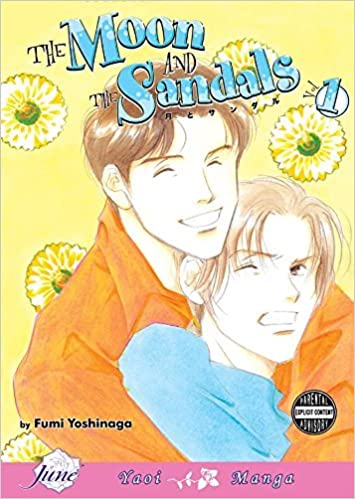
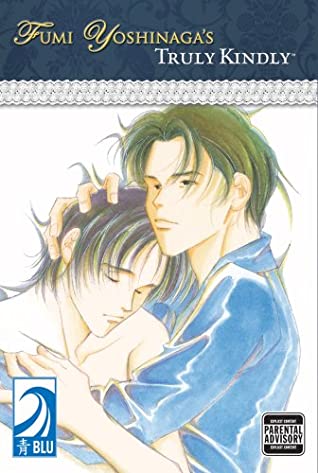
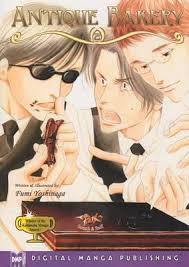
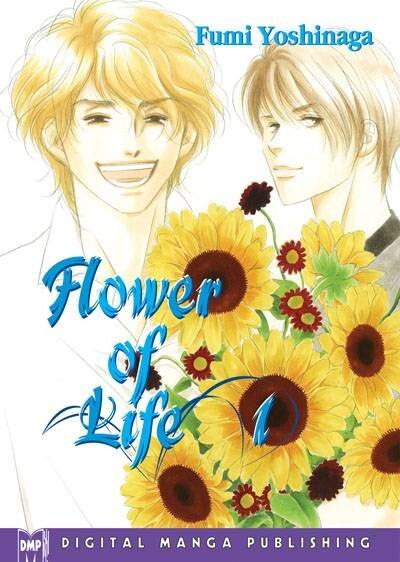
She began her career in the early 1990s, making doujinshi (self-published comics) and participating in Comic Market and other doujinshi events. She made her official professional debut in 1994 with The Moon and Sandals, in BL manga magazine Hanaoto published by Houbunsha.
Interestingly, Fumi Yoshinaga still continues to make BL as both self-published doujinshi and works that are published in magazines, and she can often be found at Comic Market with a new doujinshi from ‘classic’ manga series by other creators including Slam Dunk, Rose of Versailles, and Legend of Galactic Heroes… as well as doujinshi of her OWN SERIES, showing the ‘sexy’ stuff too hot for the pages of the magazine!
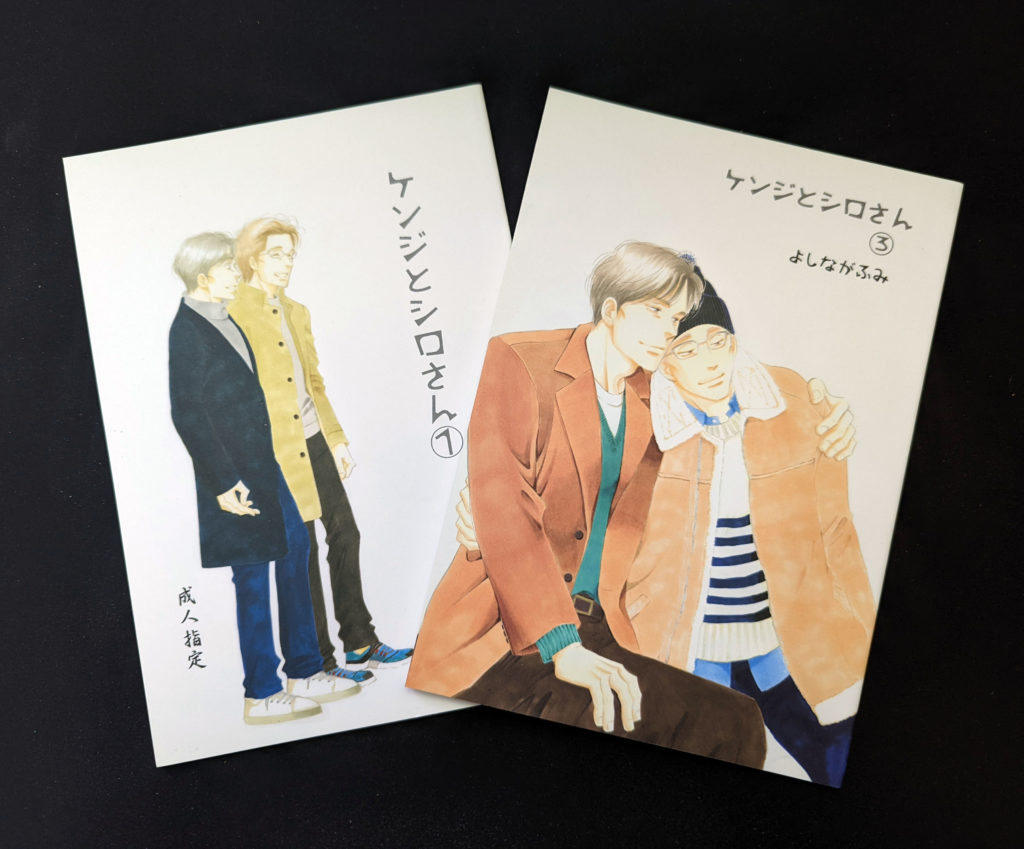
I checked my collection and it turns out I still have the two doujinshi I bought from Yoshinaga-sensei’s booth at Comiket a few years back. These are Yoshinaga doing ‘extra scenes’ from her own manga, What Did You Eat Yesterday?, featuring sexy-times between the two protagonists. They’re somewhat tame by contemporary doujin standards, but kind of great too.
Yoshinaga’s work in English runs the gamut from shojo to josei to seinen manga, as well as lots of BL. Published in the first decade of the 2000s and now sadly out of print (not even digital editions!!!!) are stand-alone titles and series’ including her debut The Moon and Sandals, and Antique Bakery, Truly, Kindly, Garden Dreams, Gerard and Jacques, Lovers in the Night, Don’t Say Anymore Darling, Ichigenme: The First Class is Civil Law (which is actually a pretty smutty story given its title!), Flower of Life, and Solfege. I might’ve missed some!
Much more in-print and available (all in digital too) are today’s book, All My Darling Daughters, and her two long-running ongoing series’ Ooku: The Inner Chambers and What Did You Eat Yesterday?
Ooku: The Inner Chambers is a speculative-fiction historical story about a plague that kills off 3/4 of the men in Japan, leaving women to rule the country, published in English by VIZ Media. FYI, the last volume of this 19-volume series was recently published, so if you haven’t read it yet, now’s a great time to binge-read.
What Did You Eat Yesterday? is about two gay men sharing their lives together in Tokyo, and cooking for each other, availalable now from Kodansha. Interestingly, a book we talk about a little later, Not Love But Delicious Foods (a single volume collection of food-centric short stories, published by Yen Press), seems to be going permanently out of print. If you see it out there, snatch it up. And Yen Press, if you’re reading, I promise we’ll do an episode on that manga if you bring it back into print (or even offer it as a digital version).
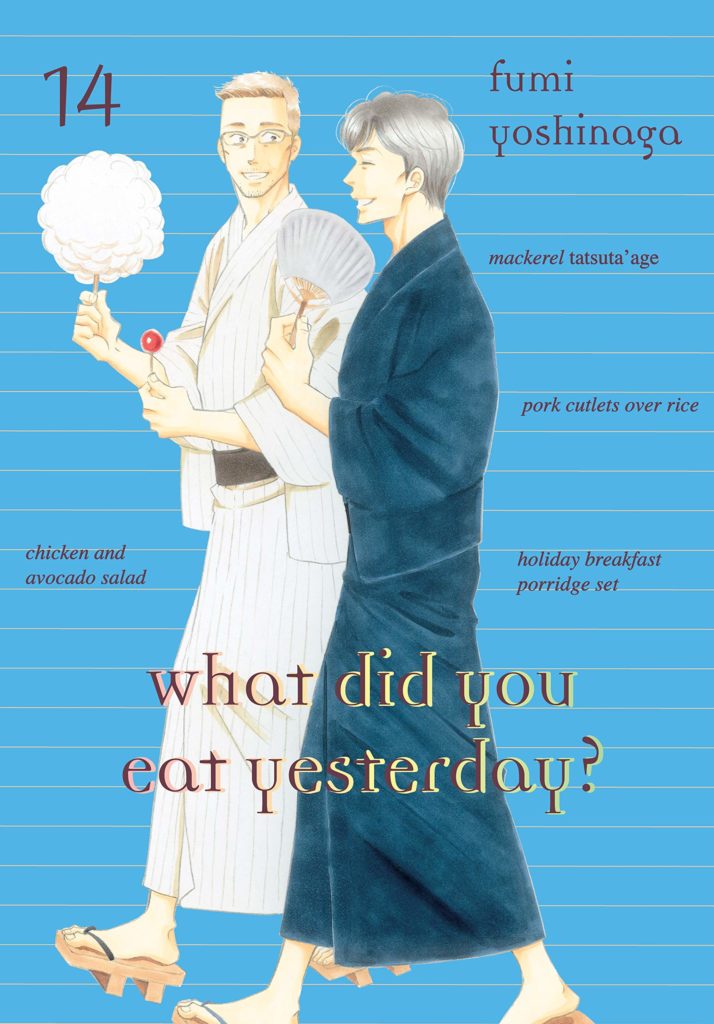
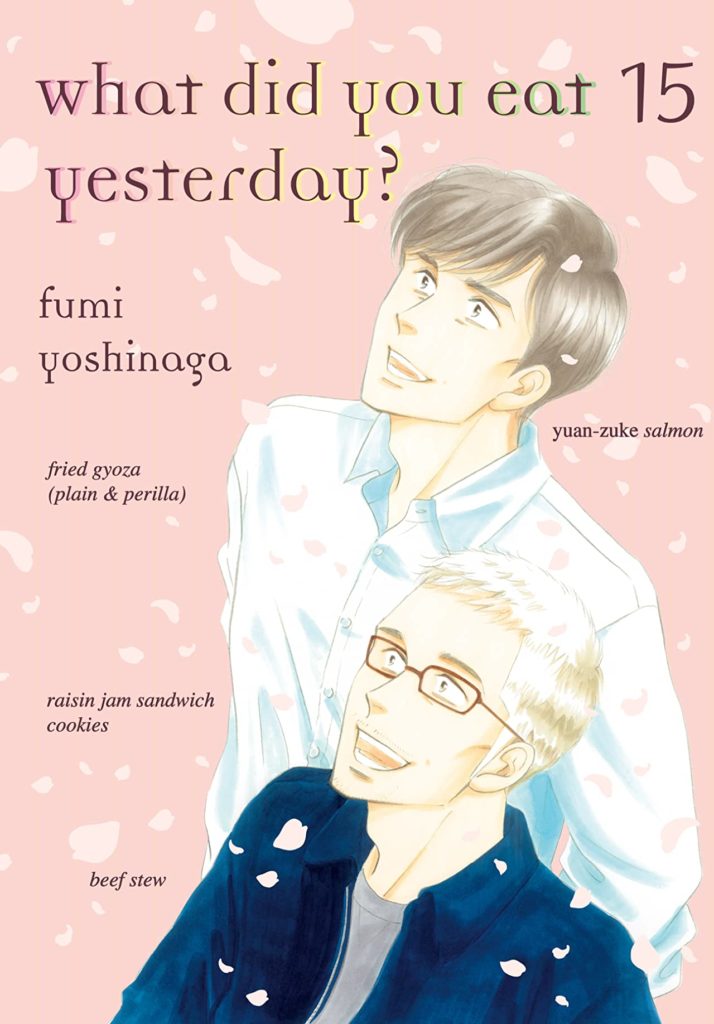
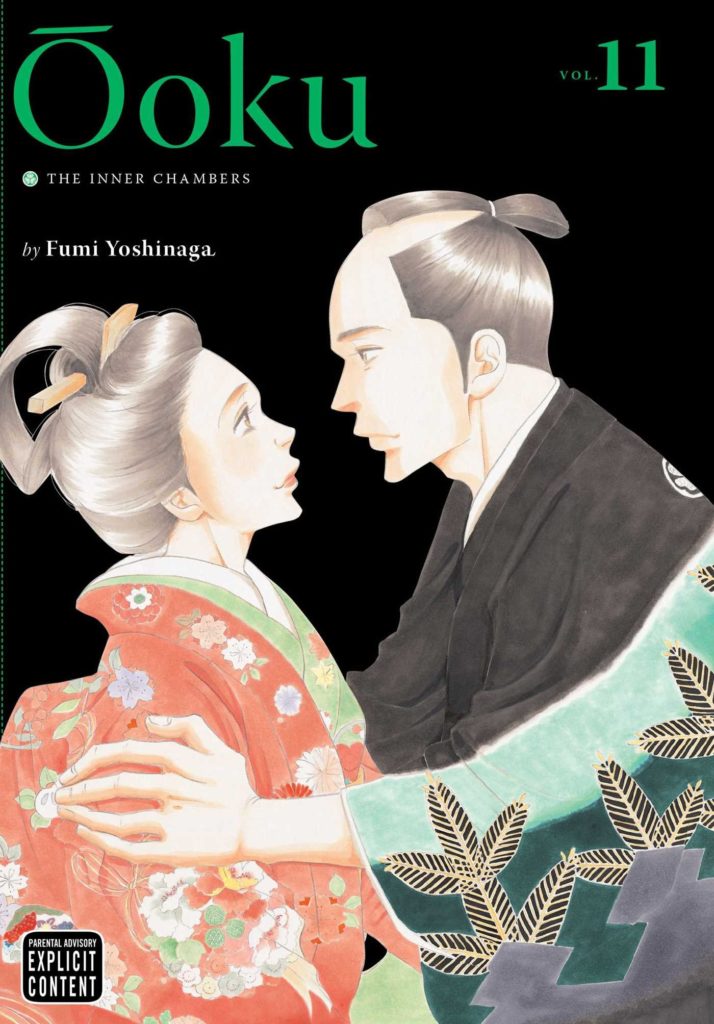
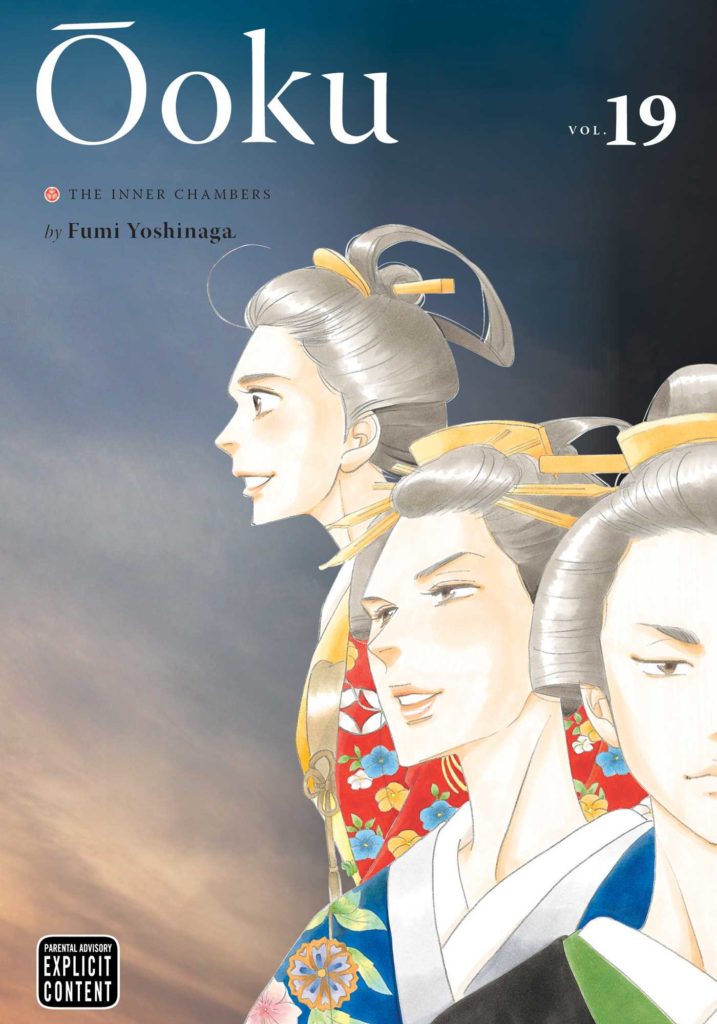
Yoshinaga is very secretive. The photo we have up top is unattributed and otherwise there are no photos of her online (EDIT: It wasn’t her, we removed it!), and she doesn’t seem to have an online presence either. I’m not even sure if she’s actually AT her booths at Comiket, but having visited, many excited women are happy to sell you her doujinshi. As you can probably tell, Yoshinaga is an absolute legend in my opinion, and anything we can do to put some shine on her name is a good thing, IMHO. I hope after today’s episode more people will go check out all of her work!
01:30 Here’s what the publisher and also David had to say about this book:
Yukiko, a salarywoman in her thirties, still lives with her mother Mari. But their relationship suffers a sudden change when Mari announces that she’s getting married–to an ex-host and aspiring actor who’s younger than Yukiko. Yukiko, convinced he’s out to fleece her mom, can’t stand to stay in the house and decides to move in with her boyfriend.
-VIZ Media
And… this isn’t really what this is about, but that’s not wrong, either! It’s actually 5 short stories, which are book-ended by the story of Yukiko and her mother Mari, and maybe more importantly, Yukiko’s grandmother. The stories in between those bookends illuminate how we all make choices in our lives, and are affected by those choices and the things outside of our control. It’s very, very good! It also has problematic elements, as we’ll get into in this episode.
02:30 So at the dawn of the Manga Boom in N. America, Fumi Yoshinaga is a creator who was widely published (as we got into up top). I think everything she had created (that wasn’t doujinshi) to that point was licensed, translated, and published in English. The main publishers were Tokyop, and their “BLU” line of BL (usually adult-oriented BL), and the I’m-not-sure-if-they’re-still-called-DMP / Digital Manga Publishing and their “801 Media” line of extra-spicy BL Manga. The BLU and 801 Media imprints for these two companies went out of print around the time of the manga industry ‘market correction’ from 2010-2012, mostly spurred by the bankruptcy of Borders books. We should probably talk about all of that at some point?
Actually while researching the above, it looks like several DMP and 801 Media titles are still available at RightStuf, including Yoshinaga’s Ichigenme. I can’t tell if these are just the remnants of 801’s going-out-of-business sale, or they’re digital print-to-order, or what?
Okay, actually, it looks like ALL of the remnants of the DMP/801 Media titles are actually sitting at RightStuf…? Go get your OOP (out of print) books I guess. Here’s the thing though, none of the books on the RightStuf site have the author’s names ANYWHERE in the descriptions. Haha, oh man, that’s just perfect. I typed “Fumi Yoshinaga” in their search box and nothing came up, but searching by title does bring up some random boxes. So yeah, it’s out there, I guess, but… yikes.
So that’s today’s lesson folks: There’s a huge swath of this industry that acts like there are no authors of any of these books, no creators for any of these ‘properties’. It’s all just product. Though, honestly, I’ve never seen a website that simply didn’t include any authorial credits at all, that’s a new one. Anyway!
[Deb:] It’s worth noting that both Digital Manga Publishing and TokyoPop are publishing boys love manga today, albeit not republishing/reprinting the Fumi Yoshinaga titles we’re mentioning in this episode. DMP is still publishing boys love under their June Manga imprint and TokyoPop is offering both BL from Japan and Korea (along with some yuri/girls’love manga) under their Love x Love imprint.
03:00 As mentioned earlier, aside from today’s book only her two long (current) series’ Ooku and What Did You Eat Yesterday? are available digitally.
04:45 There’s some heavy, devastatingly-delivered lines in this book.
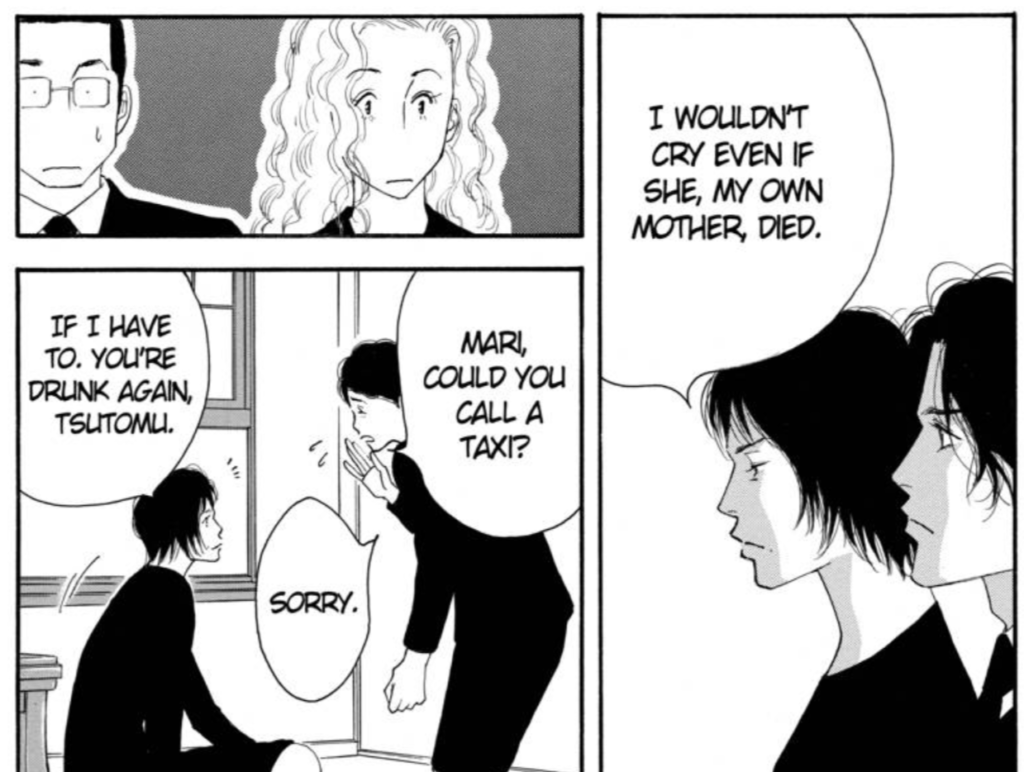
5:30 Deb will dig deeper into Akane Torikai’s book Sensei’s Pious Lie (available now print/digital from Kodansha) in the shout-outs section at the end of the episode. It’s a heck of a book.
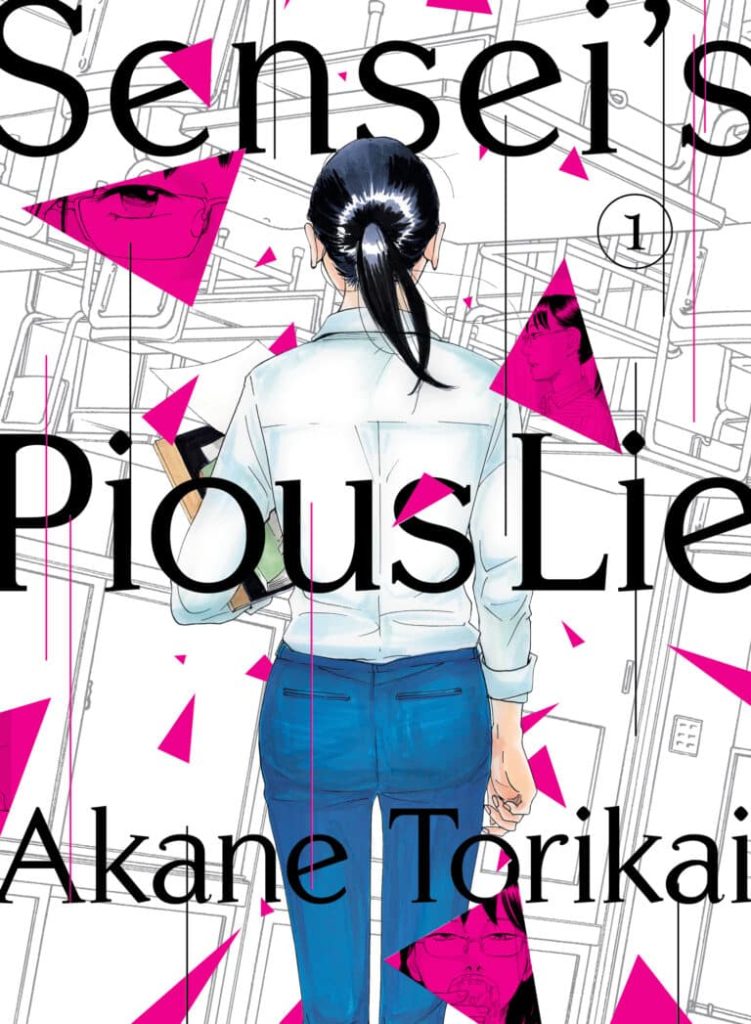
7:00 Yeah, we talk about ‘same-face syndrome’ a lot this episode, where the authors of books tend to draw the same face for each ‘type’ of character and just change the hairstyles, but it’s absolutely a real problem here when lots of different characters are being introduced, or particularly when scenes cut between characters. The transition between the third and fourth chapter in particular was a bit rough. It’s overall a minor complaint, since the work is so strong, and it’s better in her late work, as Yoshinaga-sensei pushes her art and caricature skills further. I think the wide variety of ‘everyday people’ in What Did You Eat Yesterday? is really quite nice, actually.
09:10 If this were YouTube, we would’ve been de-monetized thanks to Chip’s blowjobs.
I wrote that, and then I was going to re-write it to be clearer, then I was like “Nah, f**k it, it’s funnier to leave it that way.”
09:55 “Falling in love means discriminating among people.” Like I said, devastating, in the context of, oh, I dunno, just falling in love with a man and him falling in love with you and then realizing it could never be.

10:50 “Chris, ya dunnit again.”
11:15 As we get into throughout this episode, the second story deals with a relationship between a female college student and her male teacher, and it really did surprise me when I re-read this book a decade later… and nearly 20 years after this story was written (It was originally published in Japan in 2003). We talk about this story and how it’s handled extensively throughout this episode, it’s probably not how it would be handled today, so you’ll get a sense of whether or not it’s something you’d want to read.
12:55 There’s a real ‘advice from a stranger at a bar’ vibe to this sequence. Basically, Mari (the oldest/wisest person in the room) has a detached sort of “Look, here you go, but don’t blame me either way, we’re just drinking at the same bar” advice that’s really good, and ends up solving everything… well, er, sort of.
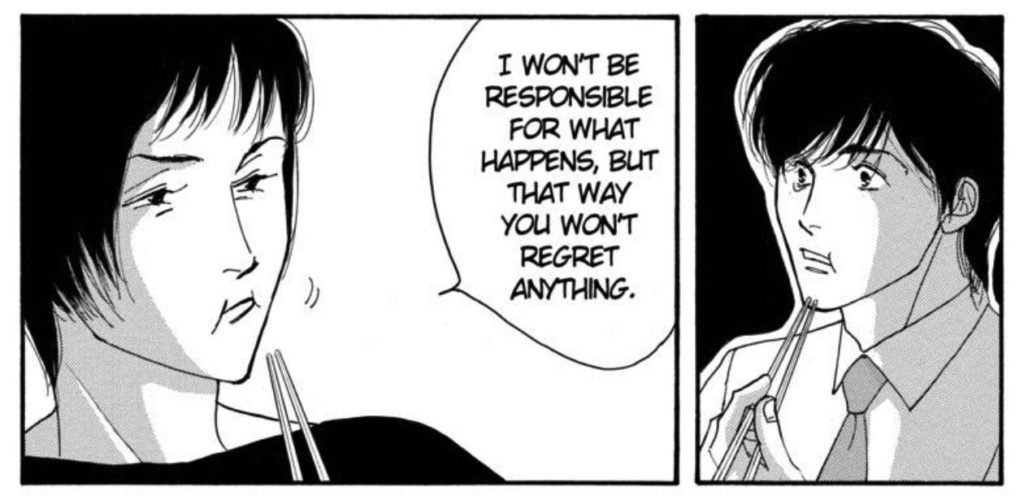
13:05 David (and Deb) mentioned a couple of previous reads from the podcast, Journal of My Father by Jiro Taniguchi, and Vinland Saga by Makoto Yukimura. They’re both great books and some of our best episodes. Definitely give them a read (or at least listen to our episodes). David also points out that Vinland Saga is one of the first multi-volume omnibus editions we assigned to Chip, though he describes events that come up later in the series (beyond the first 2 volumes that we covered in our podcast episode).
13:34 We didn’t get an official ‘what does Chip think of the colors’ segment this week, probably because David called out this image of the woman dancing on the table of contents, and what a lovely little moment it is.
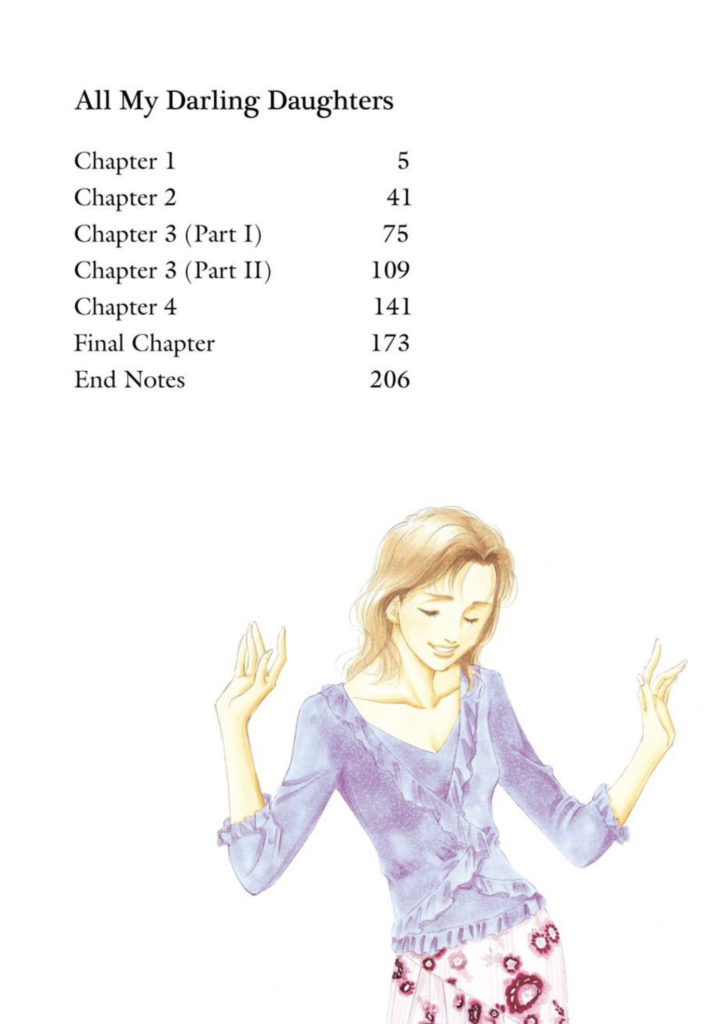
14:42 Meanwhile, there’s this great different-version-of-the-same-smirk situation, featuring Yukiko and her mom, and I think it’s such a great mother/daughter moment, that expresses what’s going on in their lives.
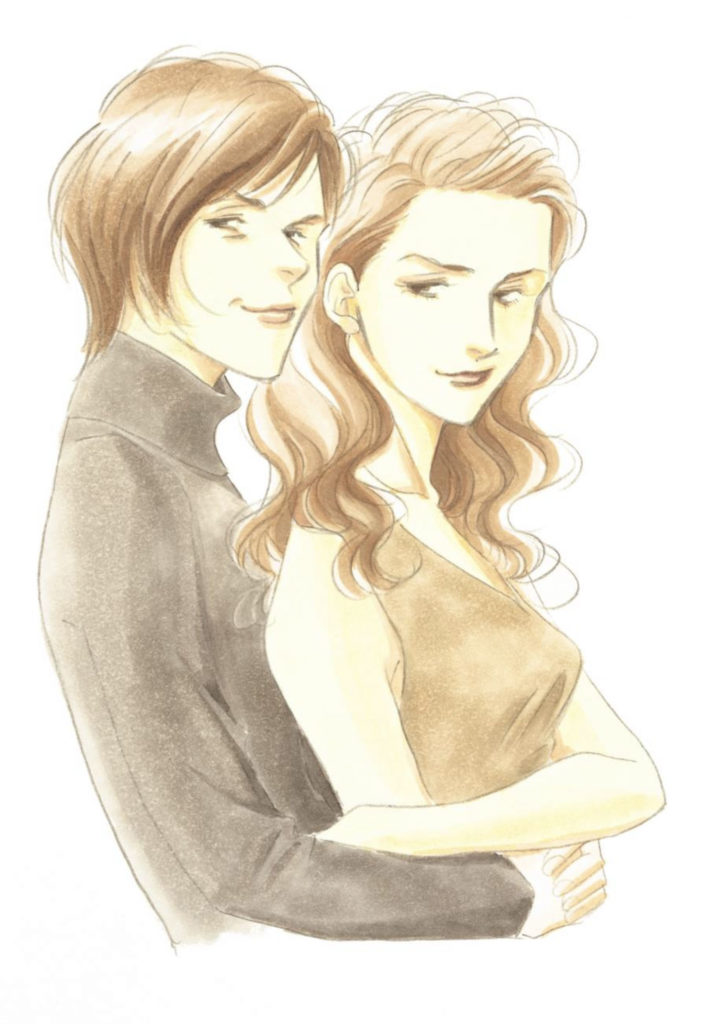
What I didn’t mention is that it comes after this double-page spread, which is even more of a dramatic mother, daughter, and uh… host-club-husband montage.
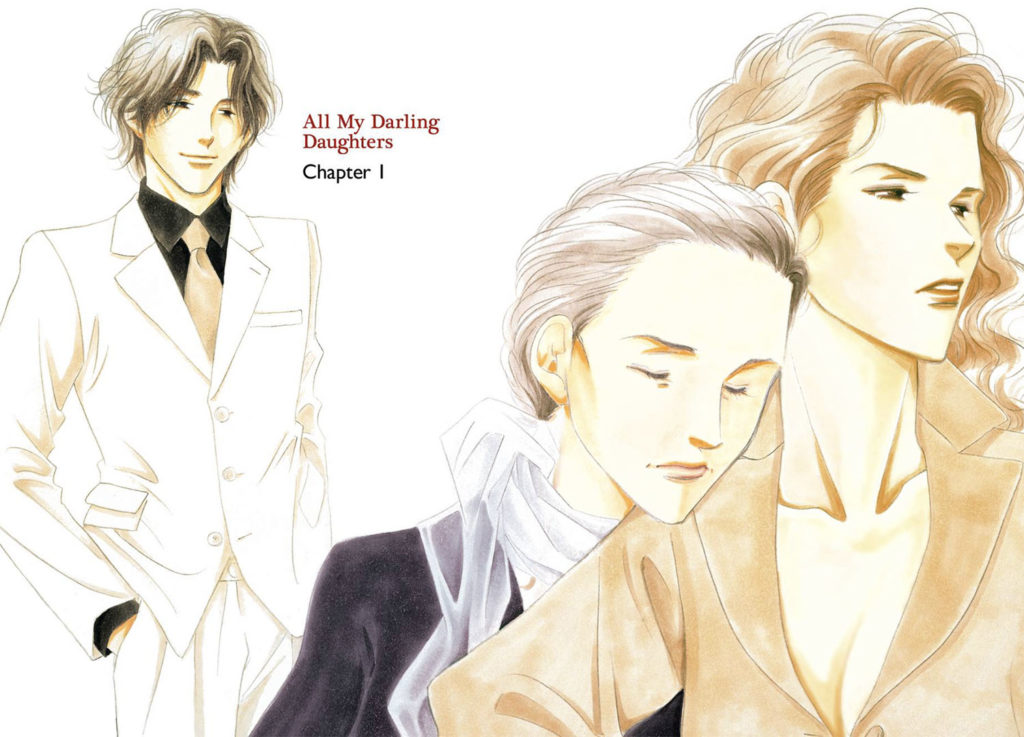
There’s such a wonderful sense of drama to this image, and really, the whole book. There are some great moments throughout the book that show some incredible body language and movement. I wish we’d talked more about the physical ‘acting’ in this book, in addition to the great facial expressions, because some of it’s really special.
15:10 Speaking of great facial expressions, Deb mentions the surprised look, on page 16. There are lots of even more extreme facial reactions, where the characters get very ‘cartoon-y’ and over the top, but keeping this one in a more realistic space while still showing the absolute shock of the situation? Pretty good. 🙂
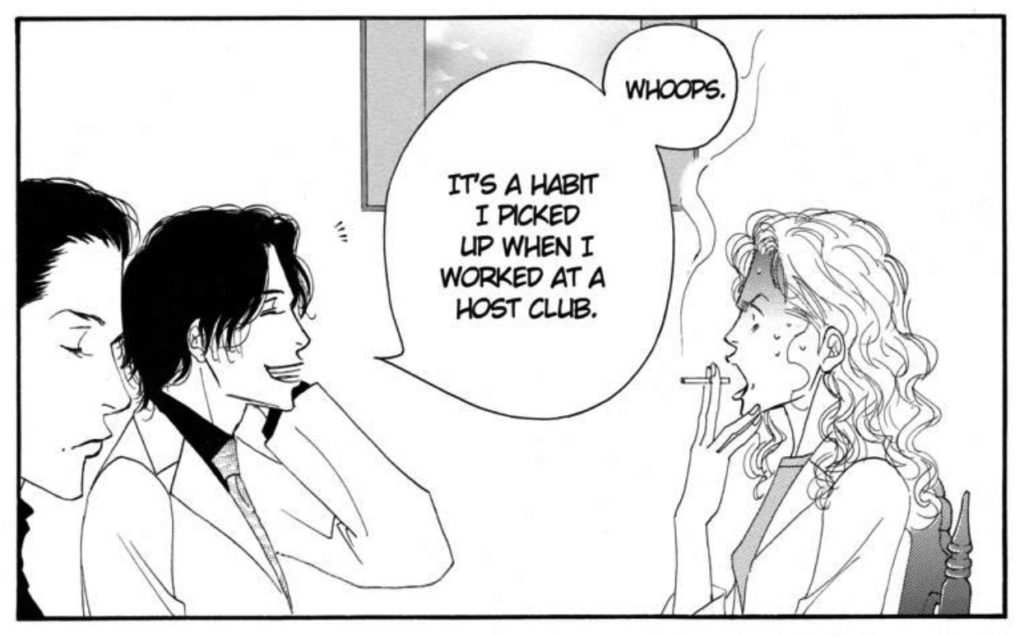
15:18 So yeah, the face-turn thing, that Chip and Deb call out is real. Those eyes are just waaaay too inset into that face, that’s really unfortunate. I stopped noticing it after a while, though!

EDIT: 16:40 The story I mention, Iguana Girl by Moto Hagio from the collection A Drunken Dream and Other Stories was originally published in 1991. This is 12 years (give or take) before Yoshinaga wrote this story, and according to Eric in the comments (thanks, Eric!) the story was hugely popular and widely read. While we don’t know for sure if it was an influence on Yoshinaga-sensei or it was just something in the air, these two stories of women dealing with inter-generational trauma caused by their moms, and their mom’s moms, make for really excellent reading next to each other… though perhaps a little heavy. Anyway if you want to know what we had to say about it (spoilers: loved it), check out our episode on it.
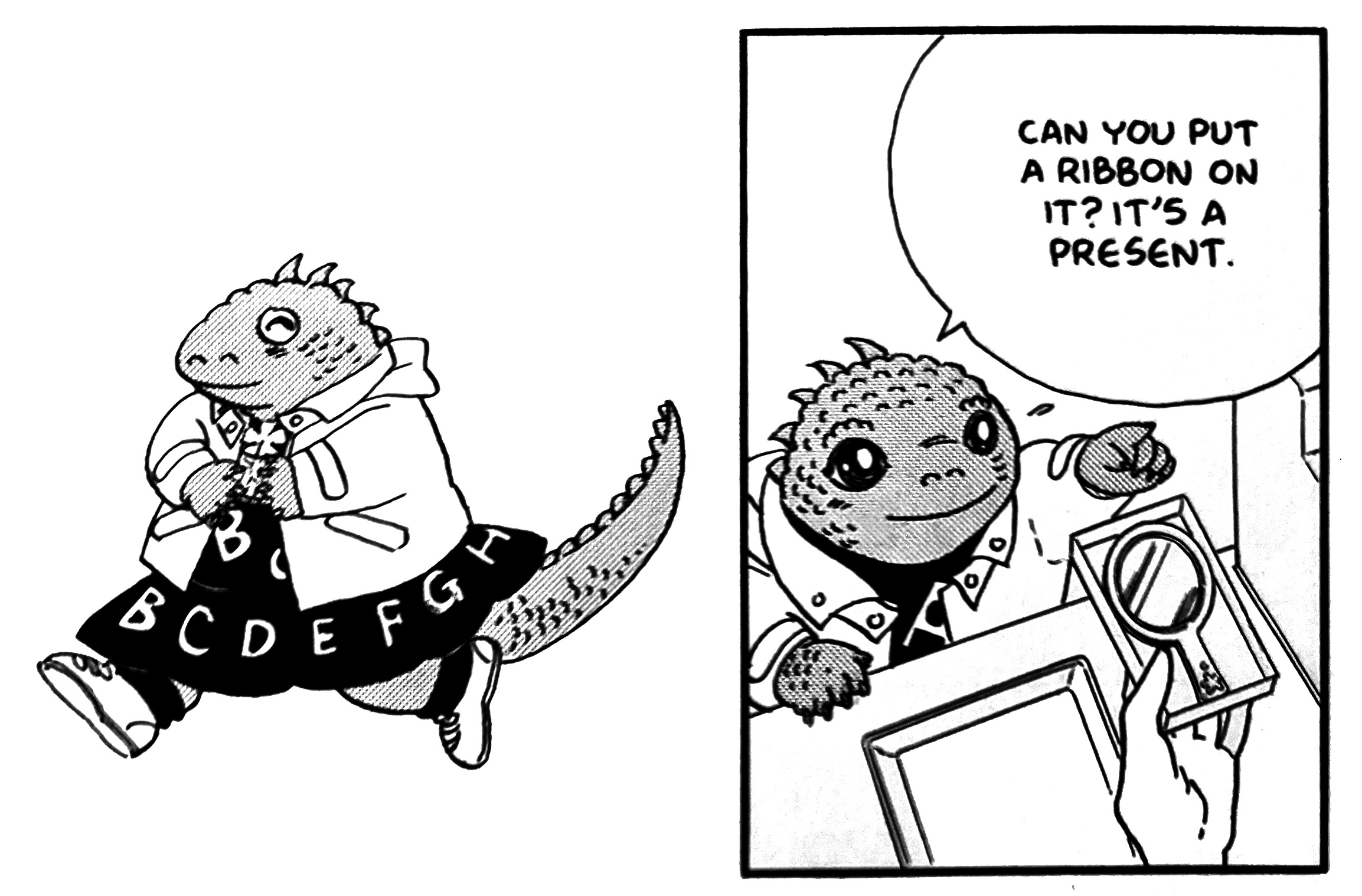
UPDATE 2022/06/27: Actually, it was directly inspired by Iguana Girl! One of our awesome listeners, NovicefromFE, wrote in to let us know that in a special interview Yoshinaga said the lack of understanding between mother and daughter in Hagio’s Iguana Girl was a direct inspiration for All My Darling Daughters! You can see the interview link above, and on this info page about Hagio’s Iguana Girl, it references the Yoshinaga story too.
NovicefromFE gave us an ‘unofficial’ translation of the text on the pages above, for those of you who aren’t auto-translating languages in Chrome:
“萩尾先生の描く娘に理解のない母と娘の関係を自分の母と祖母の関係に見たよしなが氏が「愛すべき娘たち」という作品を描いた話。”
Fumi Yoshinaga felt that the relationship depicted in “The Iguana Girl” between a mother who does not understand her daughter and her daughter is similar to the relationship between Yoshinaga’s own mother and grandmother.
That is why she wrote “All My Darling Daughters”.
Translated from MotoHagio.net
—
On that note, the reveal of why the grandma needled her daughter all her life (and gave her a hell of a complex) is just… well I’ve said devastating a few times today, but damn. (Remember to read right-to-left.)
19:54 Look, we said spoilers up top, but yeah, this book really does end on a grim, very funny joke that we are absolutely going to spoil here.
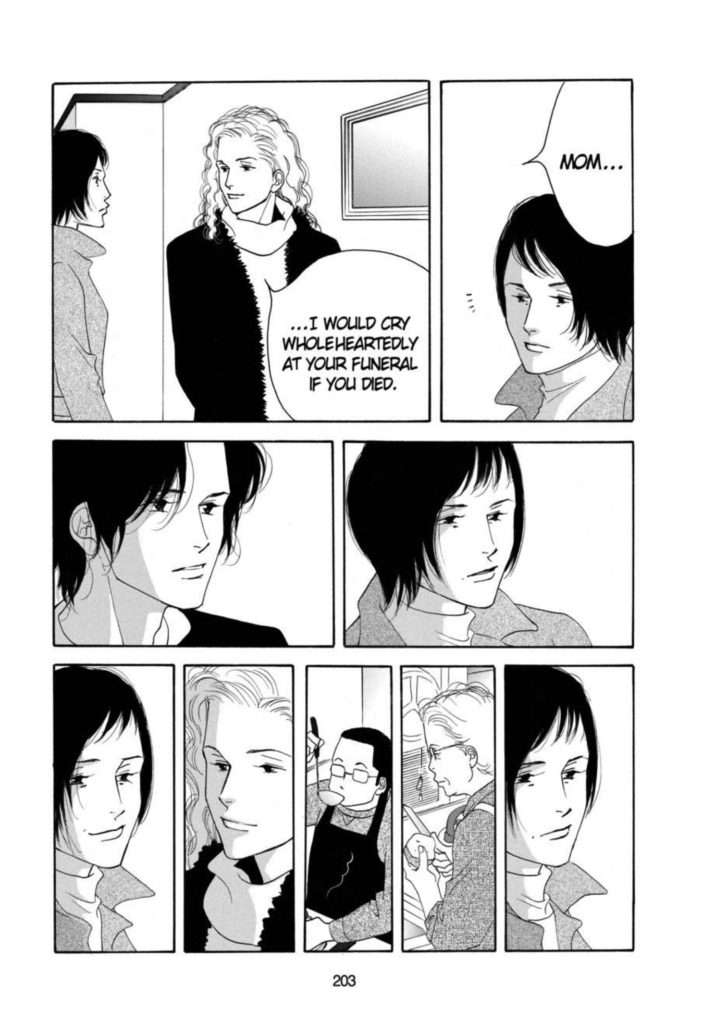
Trust us, it’s heartwarming.
22:15 Lots of personal stories this week.
25:15 This isn’t really a question we ask directly very often, but I was genuinely curious: Is this book of short stories good enough that you’d want to read more from this author? I think it’s interesting to ask directly, and I appreciate David answering directly. Chip on the other hand… 😛 Haha, but seriously. Curious to see if we do another one some day.
26:10 Not to go too deeply into here, but I’ve got a few problems with the translations of Ooku and What Did You Eat Yesterday?. It’s not really fair to do a drive-by on these series, I still happily recommend both of them (with caveats), and maybe we’ll dig into it more if we ever do these series’ on the podcast. I hope we do!
26:25 As mentioned up top, Yoshinaga-sensei’s autobiographical manga short-story collection Not Love but Delicious Foods Make Me So Happy is currently ‘between printings’ with no digital version available. Still, if you see a copy grab it, it’s a solid read.
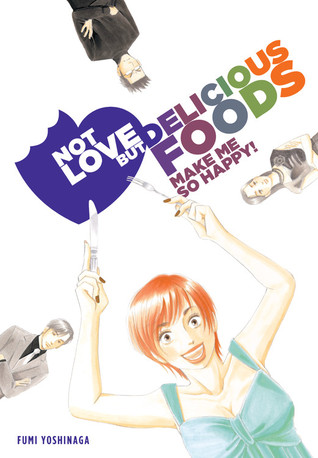
28:30 We’re talking about movies and TV and it’s not even the shout-outs section! Here’s a little bit about Love Life starring Anna Kendrick, that David mentions. Looks good.
29:20 So… yeah. The resolution? The punchline? I’m not sure what, of the third story in the book, is that the undiscriminating woman who has love in her heart for all people… becomes a nun and joins a convent. It’s a surprisingly touching, and surprisingly NOT judgey ending to the story that you really, really wouldn’t see coming. Unless we spoiled it for you?
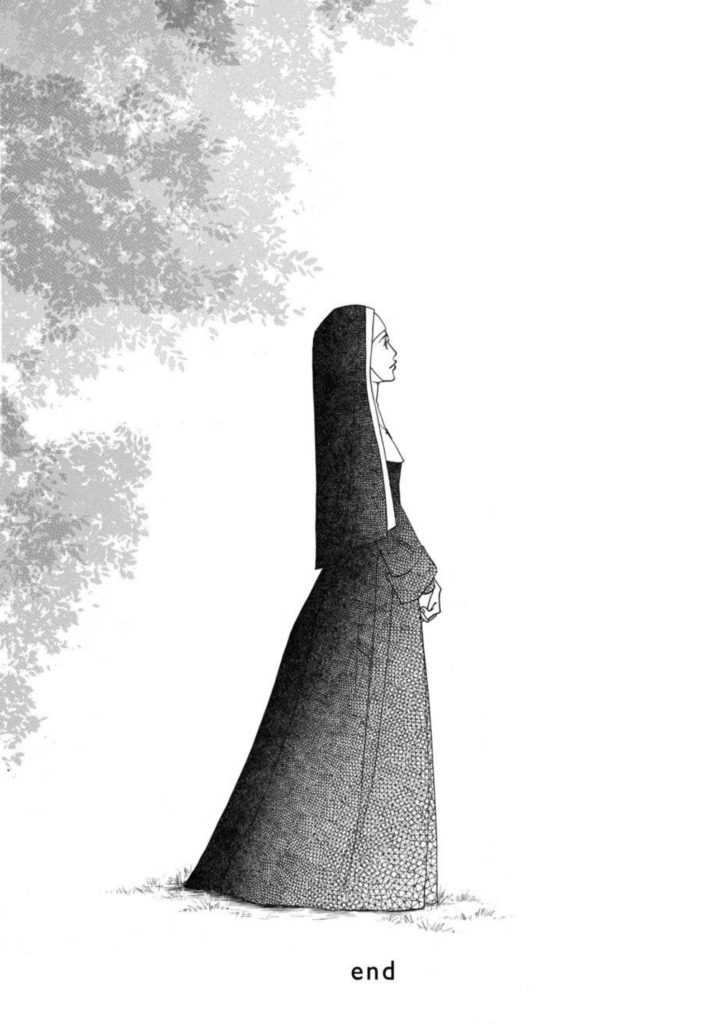
31:30 Same story, this wonderful little character moment, about noticing she’s still thinking about the stuffed animal, and they go back so she can buy it, is really nice.
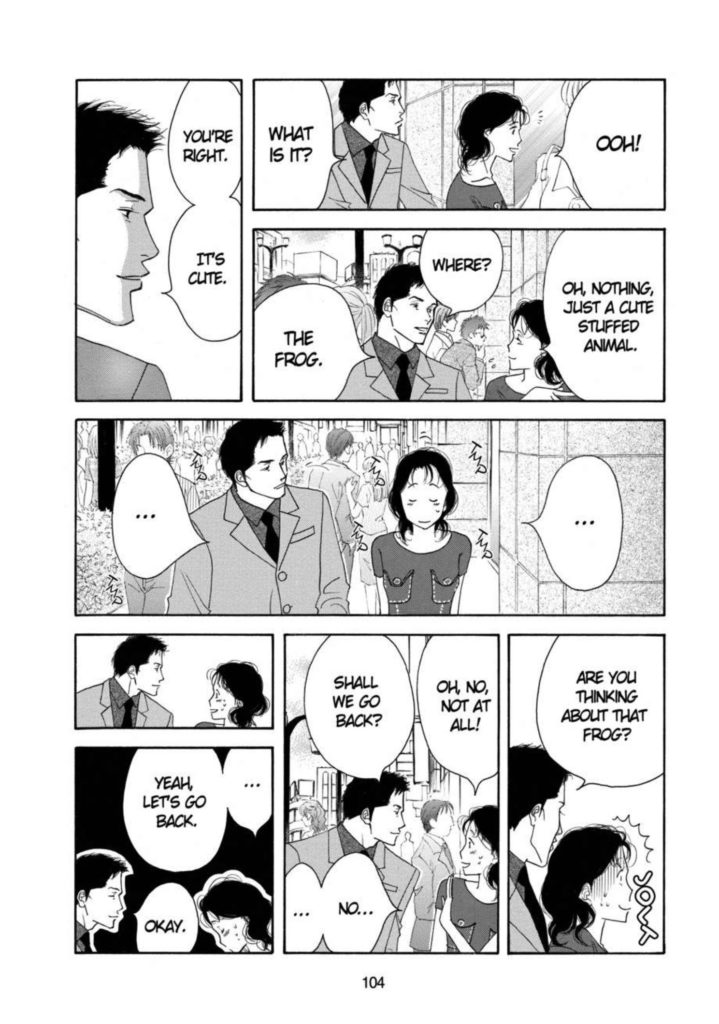
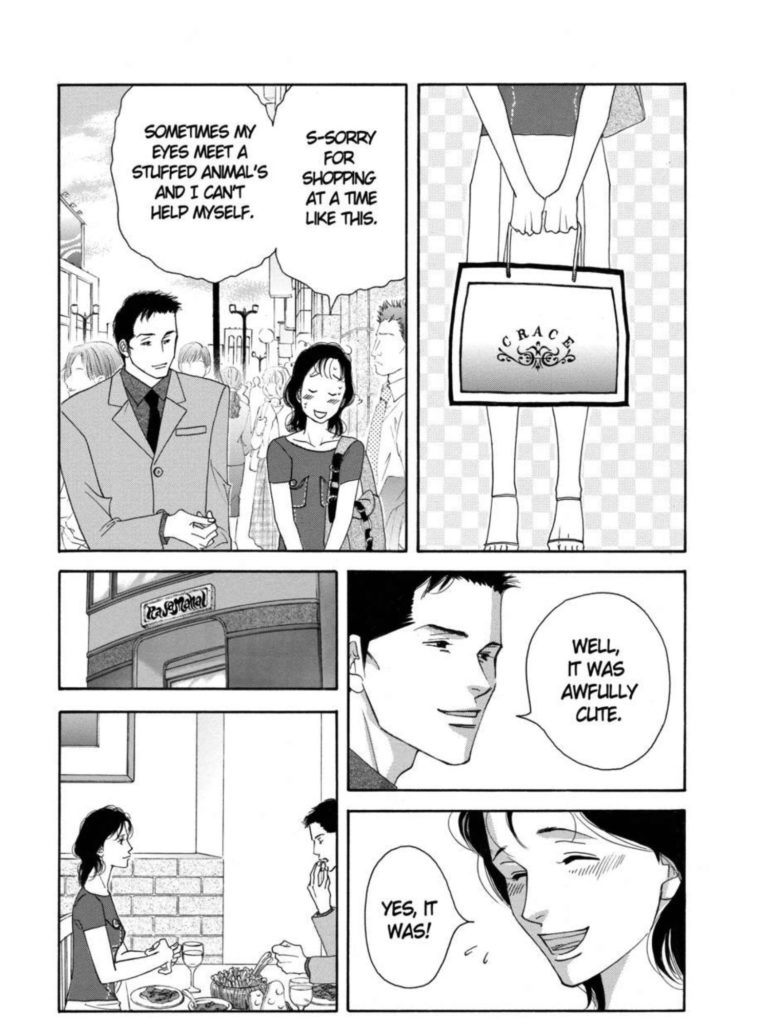
Being able to spend a few pages on this entire sequence and really let it breathe and resonate is one of the best parts about manga, IMHO. It’s not rushed, it might only be half a page in a Western comic, but it shows so much about these characters and their situation.
34:00 David calling out the amazing reaction shot when the nun’s friend finds out she joined a convent. Like I said, great physical acting in this one.
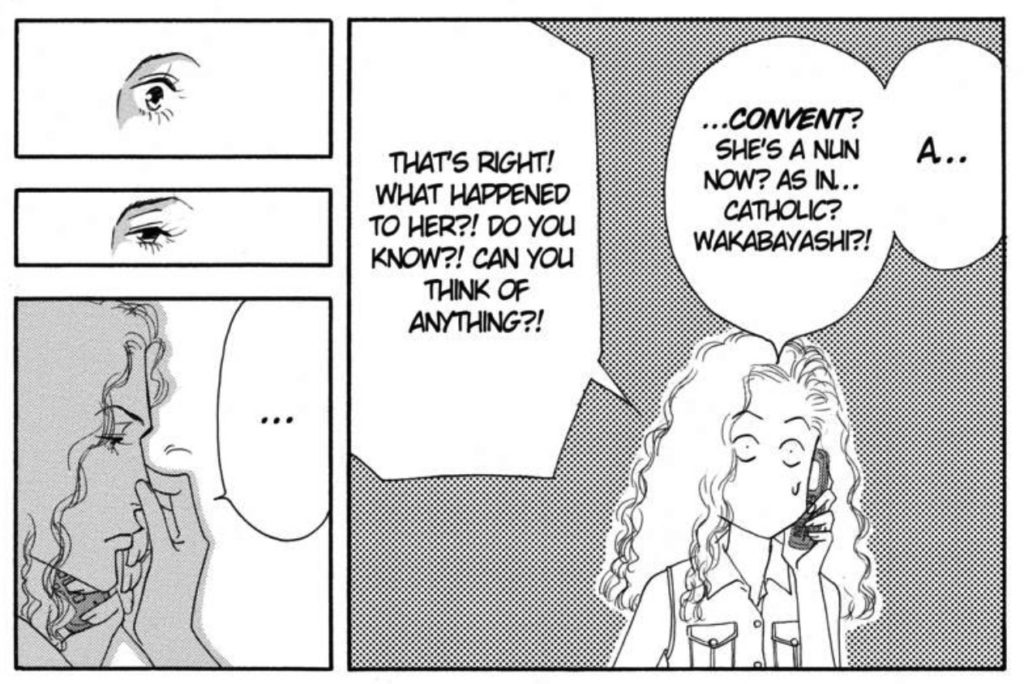
34:30 David also mentions a solid thing about the art in this one, and that’s the storytelling decision to change scenes mid-page. This is something that generally Isn’t Done in either American OR Japanese comics (happens more frequently in Franco-Belgian work), and it can create some really good, jarring-but-effective moments.
For example, (as we mention in a few minutes), the page 106-107 sequence, with the mid-page scene change for just the last panel of page 107, is really strong.
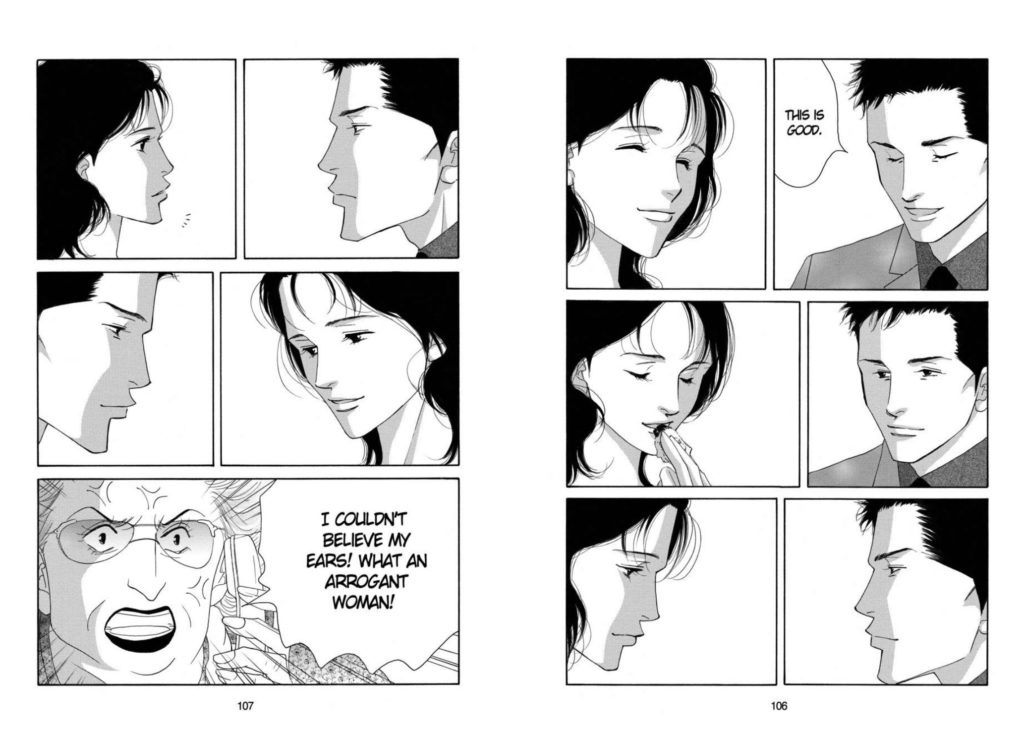
39:59 Guilty Laughs #1: No Blow Jobs. page 66
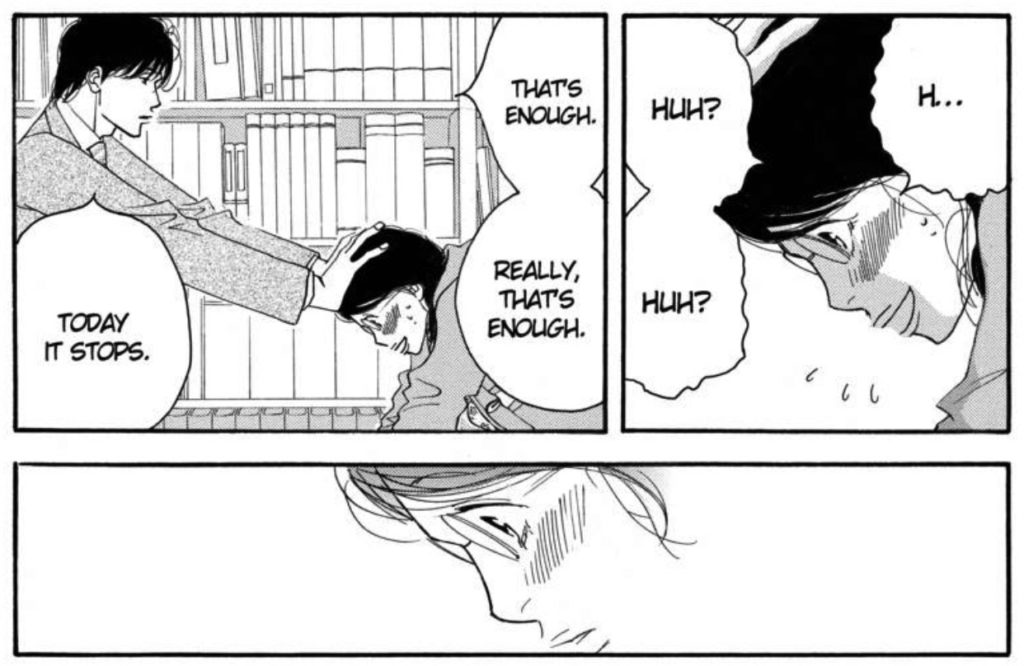
Guilty Laughs #2: Her technique was awesome, and they’re booing him! Page 52

42:05 All characters in this story are 18 years of age or older, your honour.
43:00 Well, if we weren’t de-monetized before, we certainly are now.
47:00 Yet another devastating line: “You’re still such a child.”
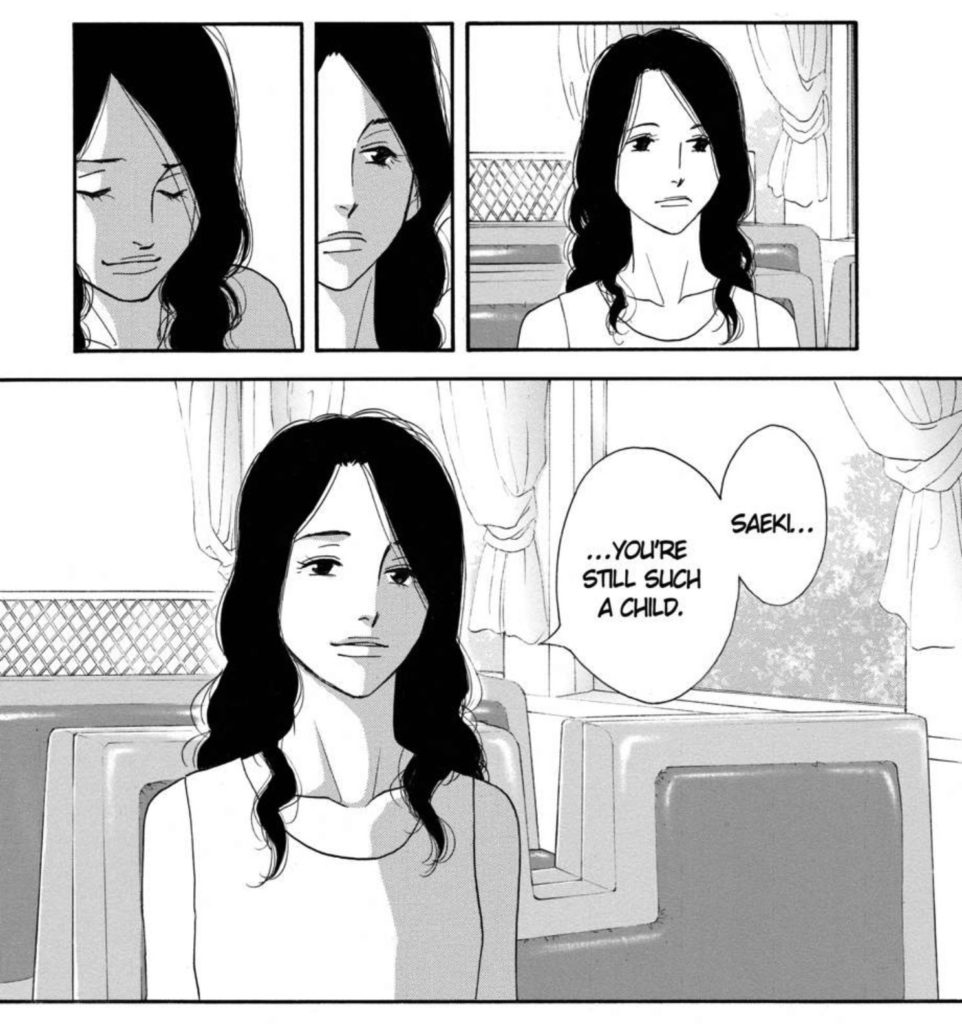
The point is driven home later in the story, that our judgey protagonist never REALLY had a handle on what her friend was going through. Even though she seemed flighty as hell and could never stick to anything, she was also probably dealing with some pretty insurmountable stuff from a position that couldn’t be understood. It’s really effective.
This reminded me of another manga I read recently, called My Broken Mariko by Waka Hirako (I honestly can’t believe that one didn’t snag an Eisner Award nomination…). Maybe check out My Broken Mariko from Yen Press — it’s a pretty unique book.
[Deb:] My Broken Mariko, like All My Darling Daughters is a single-volume story about adult females dealing with difficult relationships. Tomoyo (pictured here on the cover) stood by her friend Mariko since they were classmates, something that was especially important because Mariko had to deal with years of abuse from her father. When Mariko dies, Tomoyo goes on a mission to retrieve Mariko’s ashes from her family, and take her friend on one last journey together.
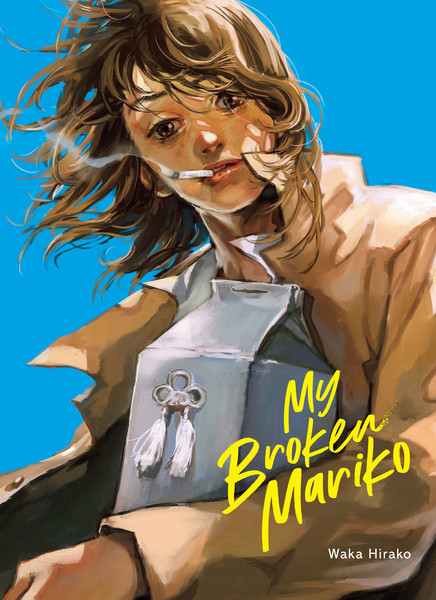
[Christopher:] Speaking of which, in a little bit Deb mentions two difficult, challenging, messy manga again. One of which is Sensei’s Pious Lie, but she also mentions Ciguatera, by Minoru Furuya. I’ll let Deb fill-in the details about that one.
[Deb:] Ciguatera is a manga that I really wanted to like, but reading the first volume was… well, it wasn’t much fun. High-schooler Yusuke Ogino is small for his age, and as a result, has to endure a lot of humiliation and abuse from bullies. But he dreams of owning a high-end racing motorcycle, and taking it on a road trip across Japan. While taking his motorcycle license test, he meets Yumi, a pretty, mature girl who shares his interest in motorcycles. Yumi gives Yusuke the shock of his life when she shows interest in him, and this chance encounter transforms his life.
I’ll probably continue to read further, since Ciguatera is described by Kodansha as “one of the great masterpieces of graphic storytelling,” but just saying that the first omnibus volume was full of very uncomfortable moments that live up to its “pitch-black humor with pathos and the awkward realities of everyday life” description from the publisher.
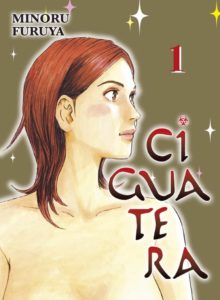
48:30 One of the things that Deb rightly calls out that All My Darling Daughters does really well is make the sexism that the female characters (and by extension, most women in Japan) must face in day-to-day life really clear and affecting. Chip mentions in a few minutes that the misogyny comes rapid-fire after Deb’s example, and the one-two punch on the page below is just so deftly handled, really good stuff.
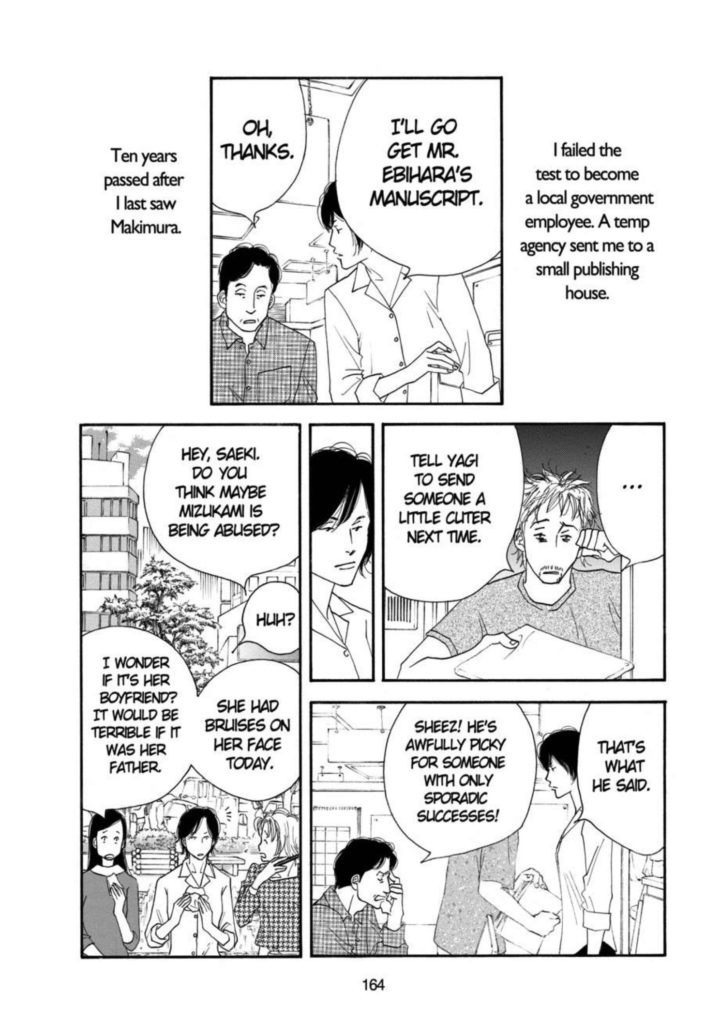
This turns out to be a one-two-three punch here, as Yoshinaga subtly links the casual misogyny at multiple levels that women face directly to a conversation about physical abuse. She knows it and has laid it bare.
50:10 Well, in true Mangasplaining fashion, we have a brutal sidetrack and mood-shift here, but man, that The Brady Bunch Movie is just so good.
After this episode, David went and watched it (as he said he would) and he loved it, and sent us this clip of the original Brady Bunch television show which now reads almost as self-parody.
Anyway, between the original conversation, David sending the clips, and then listening to this episode to write these show notes… I went and bought the movie and I’ve been watching it on the other monitor while I was typing up these show notes. I lol’d, it holds up. But I’m a bit worried about whether or not A Very Brady Sequel is any good… Still go to bat for the two Adams Family movies though.
52:55 Here are the American (and British!) graphic novels that the team recommends if you enjoyed All My Darling Daughters.
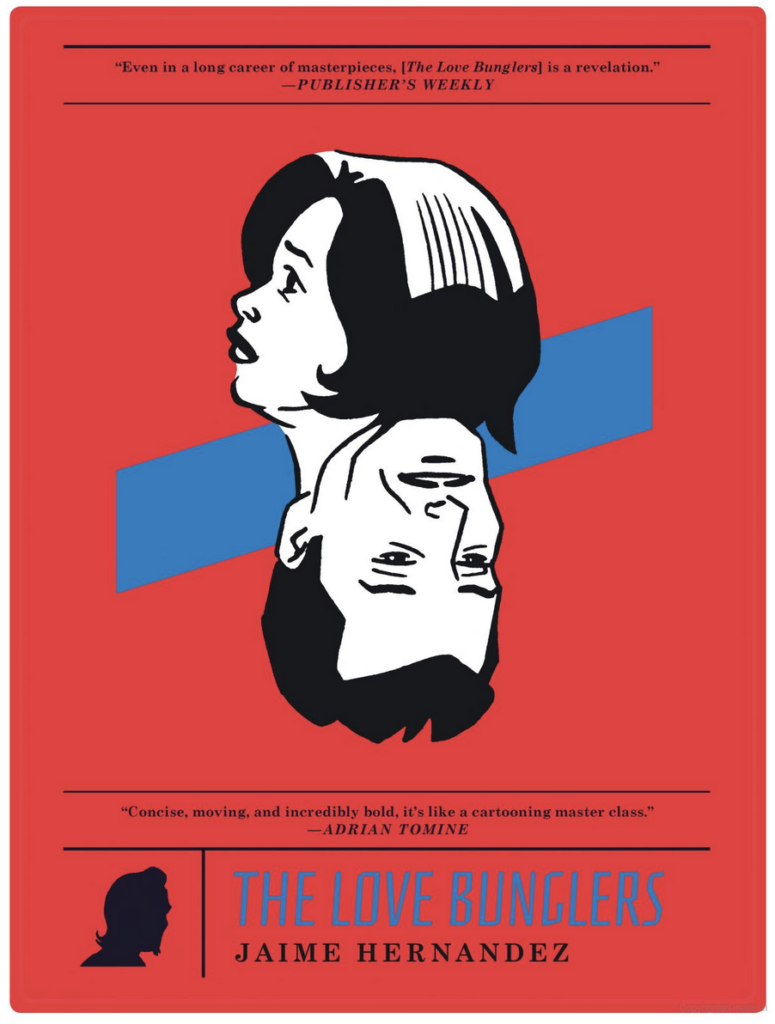
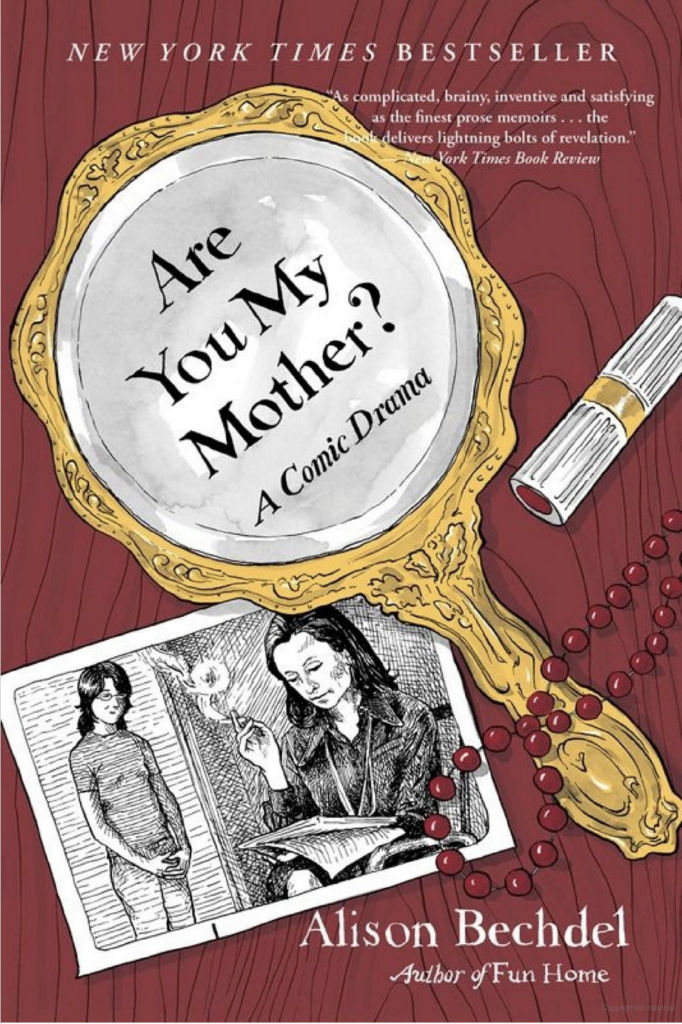

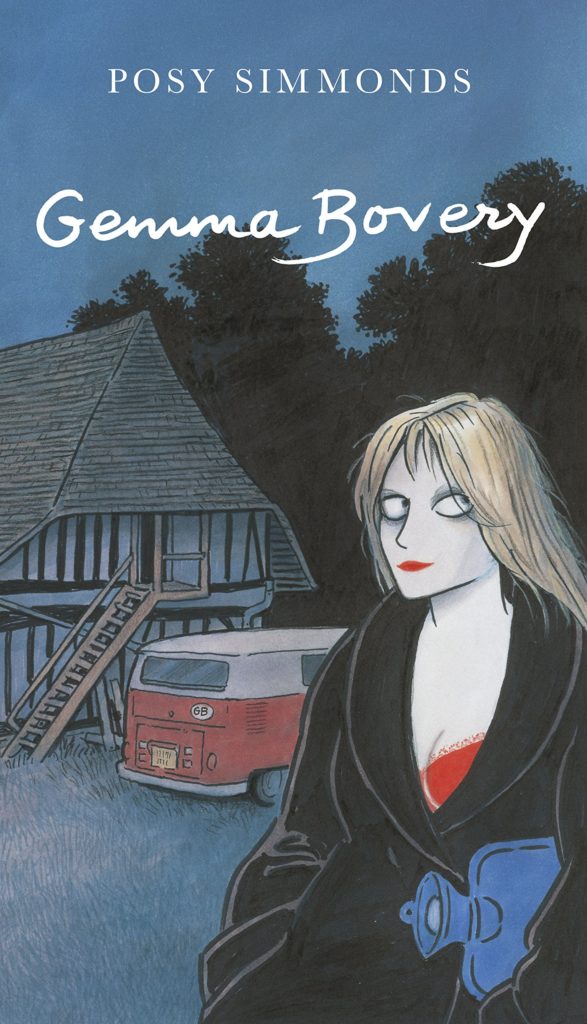
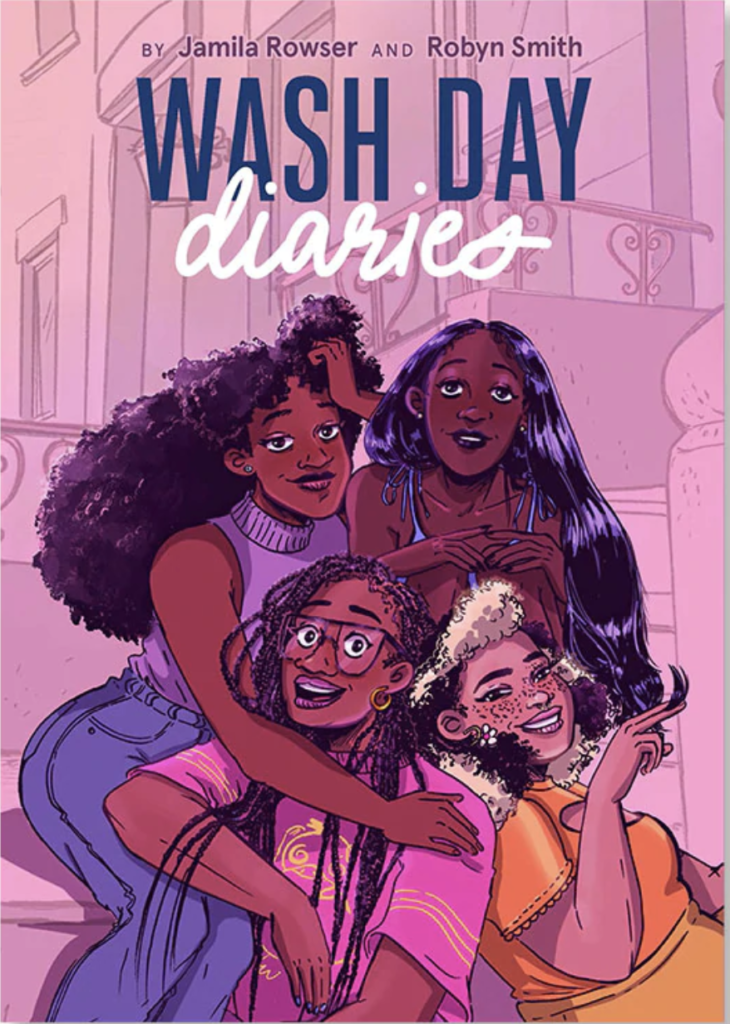
Love & Rockets: The Love Bunglers by Jaime Hernandez, Fun Home and Are You My Mother? by Alison Bechdel, the works of Posy Simmons including Tamara Drewe and Gemma Bovary, Can’t We Talk About Something More Pleasant? by Roz Chast and Wash Day Diaries by Jamila Rowser and Robyn Smith. Literally type those into any book buying website, they’re easy to buy. 🙂
1:00:00 David wants to go out on a zinger, but also a quiet moment from the book, so it’s hard to be mad. ;).
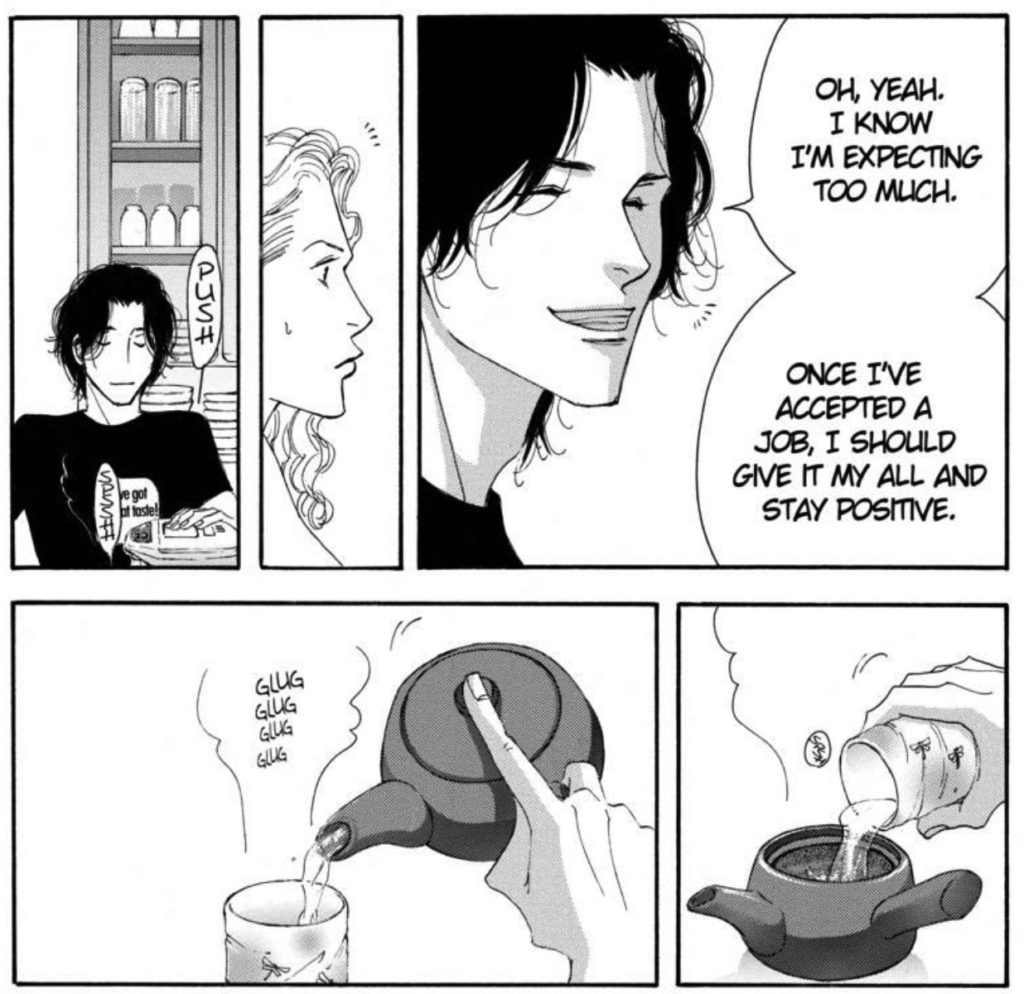
1:01:39: Hey, it’s THE BREAK
Since we’re running an ad in the podcast anyway, we’ll run a little one here too. It’s for our newsletter, Mangasplaining Extra, where we’re publishing manga and also emailing these show notes directly to you and a bunch of bonus articles are on the way too. Maybe go check it out?
And we’re back! Due to dynamic ad insertion, we’ve had to ditch the timestamps from this point on. Sorry!
It’s time to bring back the Q&A, and boy did we! Here’s this week’s question from Matthew V.:
I came across this from Manga in Theory and Practice by Jojo’s mangaka, Hirohiko Araki:
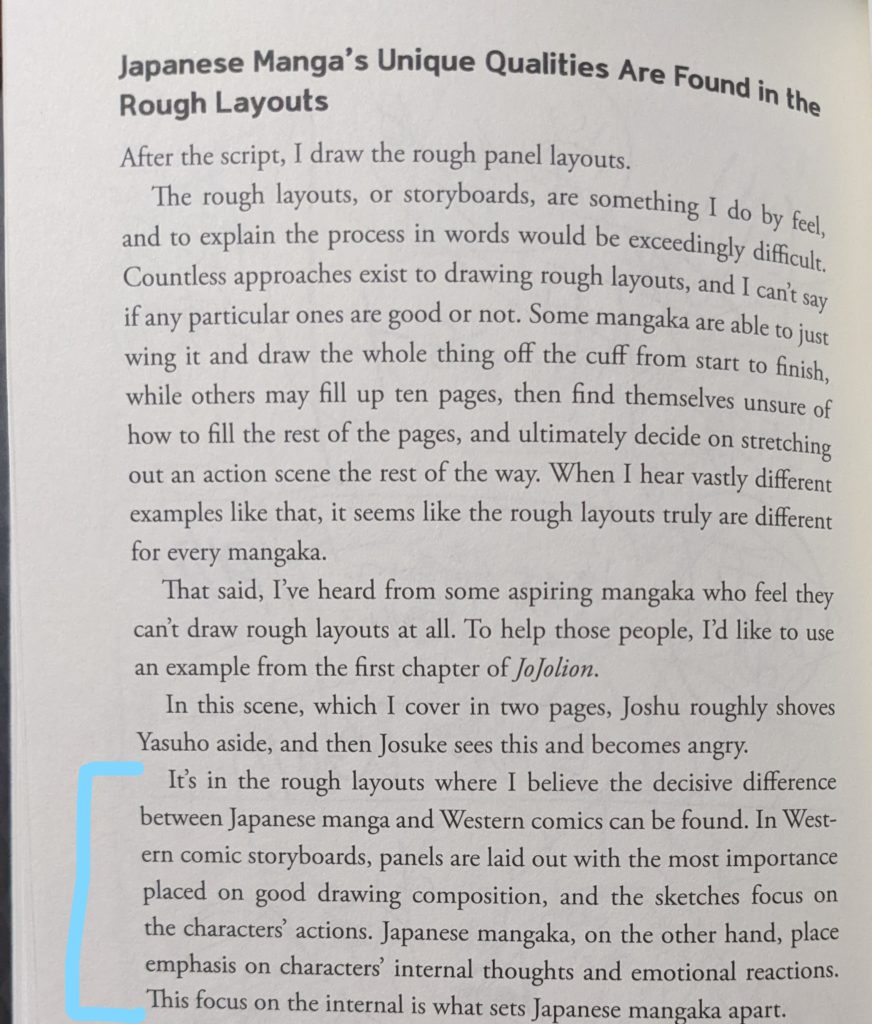
What I thought was super interesting was in the last paragraph about the difference between Western and Japanese comics. I wanted to see if y’all had any thoughts on how he thinks manga and Western comics are primarily different and if you think there’s something that defines manga from Western comics.
That’s a really interesting question, and I think we put that one through the wringer pretty well, actually. We do reference a few things in answering the question though, so here’s some of those referenced items:
ITEM: Chip’s currently serializing his new comic Public Domain for subscribers on his newsletter, go check it out. Or wait until it hits comic store shelves in June.
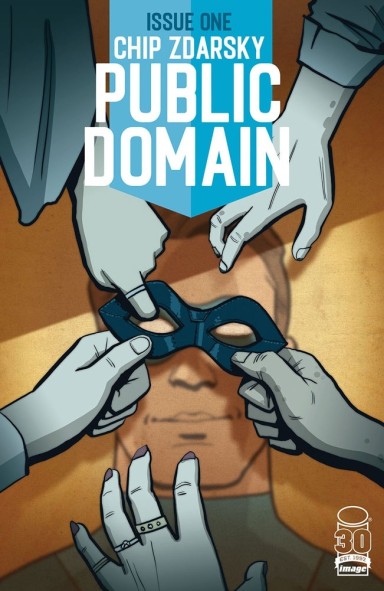
ITEM: Here’s some X-Men in a discussion about what happened to Thought Bubbles in comic books. It’s kind of surprising to see people in that forum coming down on the side of getting rid of thought bubbles and narration, I think it’s ridiculous personally!
ITEM: Shonen Jump is Shonen Jump, and the Shonen Jump way of making comics is really a thing. If you want the deep, deep, long dive into what makes a Shonen Jump manga, the series Bakuman by Ohba and Obata details exactly that in its shonen story about two dudes trying to become the greatest manga-ka in the world. I read the whole thing and it’s really well-done comics that I have super mixed-feelings about!
Meanwhile, if you want a slightly-less-fictionalized look at how Shonen Jump is made, go straight to the horse’s mouth with The Right Way To Make Jump. The first 3 chapters are free to read on the Shonen Jump site, and it digs into how the manga is made and what makes a Jump manga… Jump.
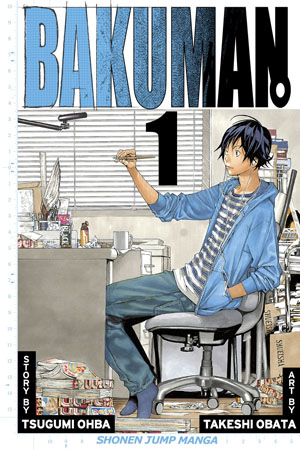
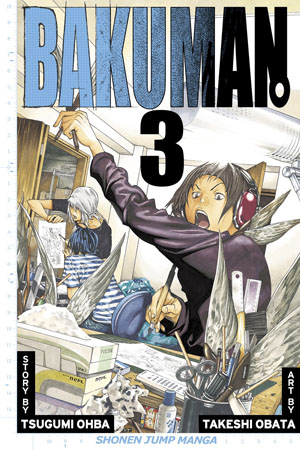
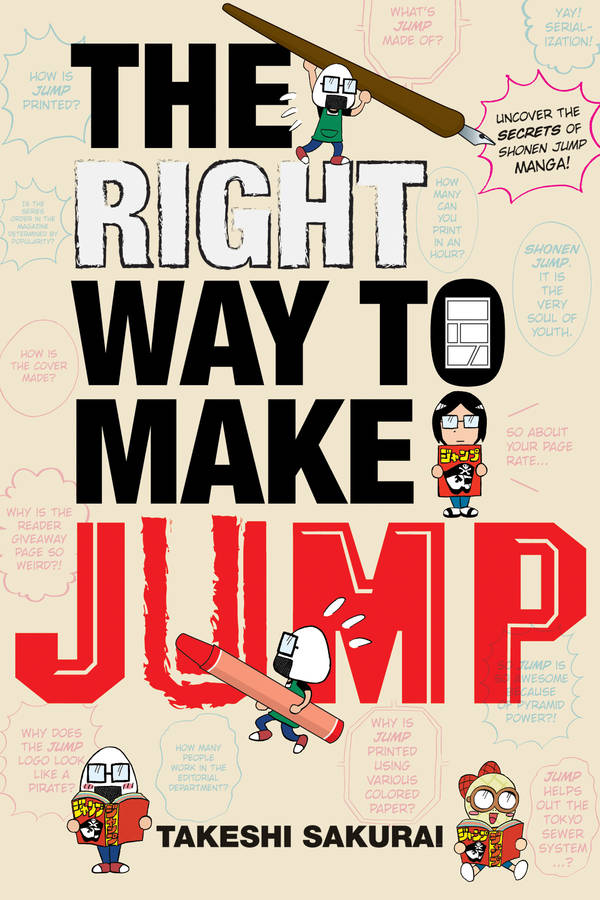
ITEM: So the great big store full-to-the-brim with used manga that Chip’s talking about? That’s Mandarake, a massive repository of used manga, and other otaku books and goods. I’ve probably spent more time in the Nakano Broadway Nakano than anywhere else in Japan that isn’t a hotel bed.
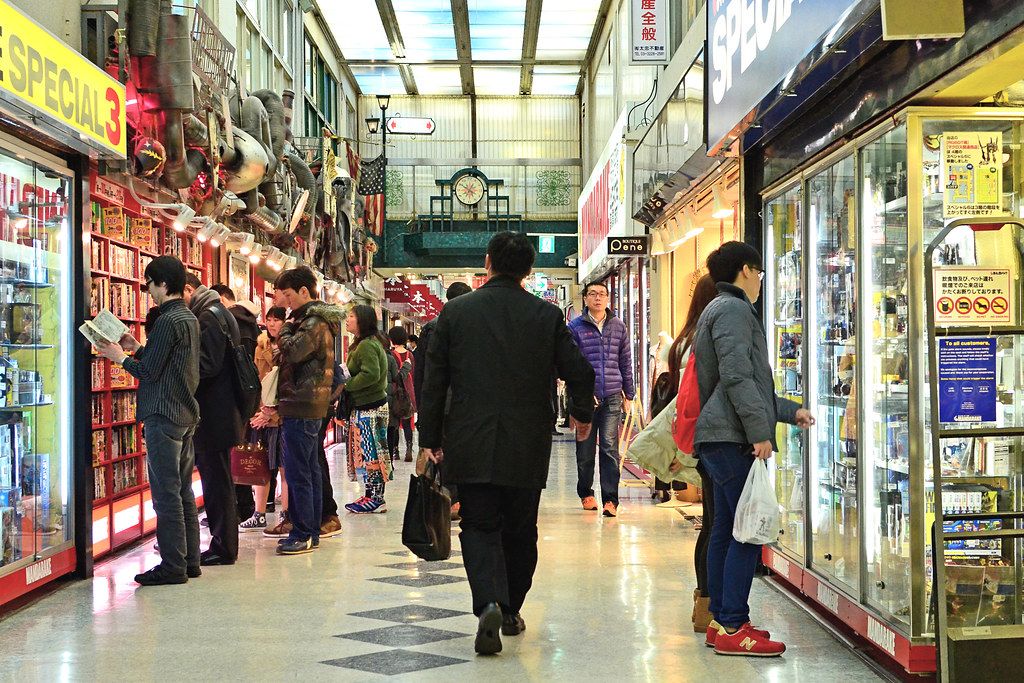
[Deb:] Mandarake has many locations throughout Japan, not just Tokyo. It’s notable for being a place to buy new and used manga, magazines, toys and other collectibles. I don’t know of any similar type of mega-store in N. America, where people can sell their unwanted pop culture goodies, and where such a huge variety of items, both ordinary and incredibly rare and unique can be found at any given time. If you have even the slightest nerdy tendencies, a Mandarake store should be on your must-visit list when you go to Japan. Mandarake has an online auction/ecommerce site available in English and an English language Twitter feed too. Since most of us can’t get into Japan now to visit and shop, this might be the next best thing to going there.
[Christopher:] Oh agreed, absolutely. I have placed an order through Mandarake since the start of the pandemic and been delighted with what I received, what a nice little treat. And I’m pretty sure the last Mandarake I was in was actually the one in Sapporo, which had a few lovely hidden treasures.
ITEM: Raina Telgemeier does love manga, though she only mentions growing up with Barefoot Gen by Keiji Nakazawa, and it having a profound affect on her–she even made a comic about it. Though the comic is no longer online, she did post a short excerpt of it here on here Twitter. I can’t find the reference to Rumiko Takahashi online anywhere, I might’ve been getting her confused in that regard with Bryan Lee O’Malley, but maybe not, not everything is online. 🙂 But speaking of Raina and manga, in this New York Times interview from a few years back, she mentions that her favourite manga is Kiyohiko Azuma’s Yotsuba&!.
[Deb:] Wanted to add the the entire Barefoot Gen series is available now from Last Gasp. It’s a semi-autobiographical story about a young boy’s travails as he witnesses the bombing of Hiroshima, and his struggles as an orphaned tween during the post-war US Occupation of Japan that was originally serialized in Shonen Jump(!) in the early-mid 1970s. It’s a dark read, but it is definitely worth checking out.
Thank you so much to Matthew for the question! And if you want to read Hirohiko Araki’s very interesting book Manga in Theory and Practice for yourself, it’s now available in English from VIZ.
Now it’s time for some Shout-Outs!
Christopher shouts out The Brady Bunch Movie, which I think we’ve already sufficiently covered.
David joins in and shouts-out the first two live-action Addams Family films, starring Anjelica Huston and Raul Julia.
Chip is happy BARRY is back on HBO, starring Bill Hader.
Deb shouts out Sensei’s Pious Lie by Akane Torikai, published by Kodansha. It’s a heavy, uncomfortable josei manga. You can read the first chapter free on the Kodansha site. Deb does a good job of both recommending it and warning you about it.
And that’s this week’s episode of Mangasplaining! We sincerely hope you enjoyed it.
Please support your local comic and manga specialty shop when purchasing these books, and you can find one near you at comicshoplocator.com. You can also check your local library for print and digital lending options, they have TONS of manga! Also, check us out at MangasplainingExtra.com, we’re doing cool stuff over there, like that Kaz comic up top. Finally, thanks to D.A.D.S. for their musical accompaniment this episode.
See you next week for Blue Giant vol 5&6!
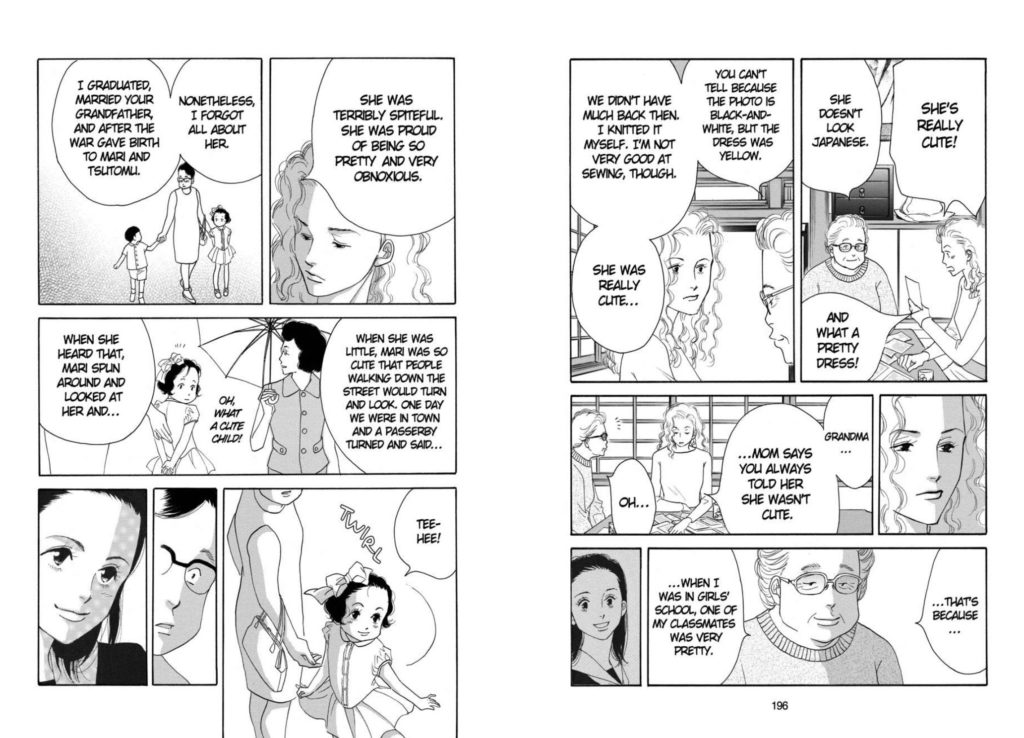
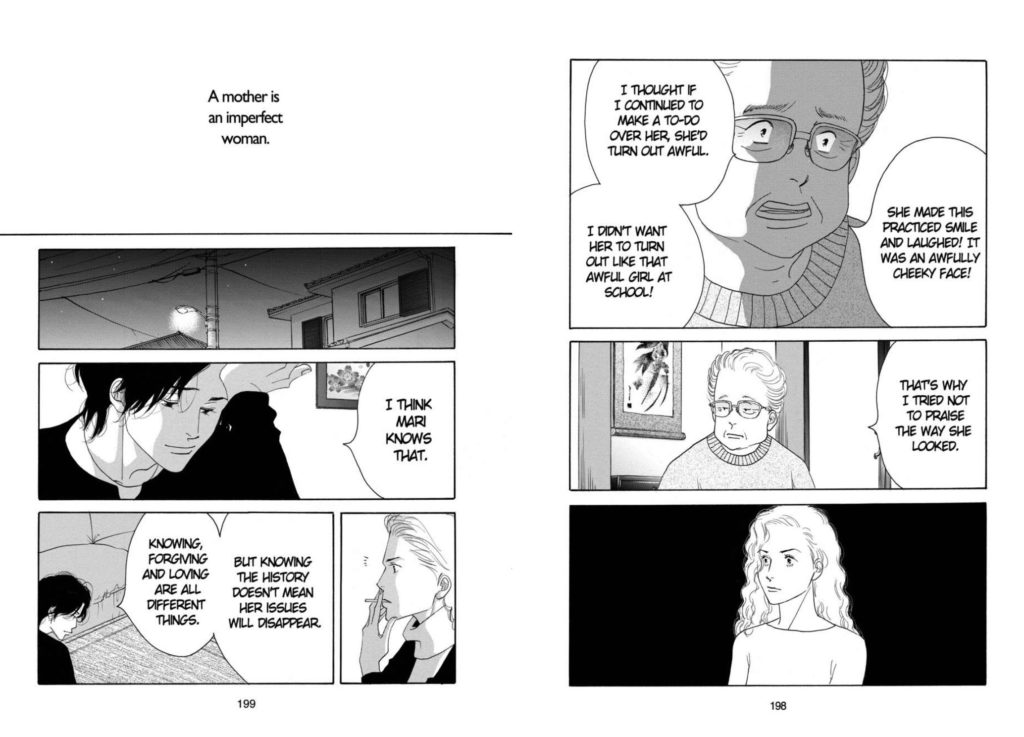
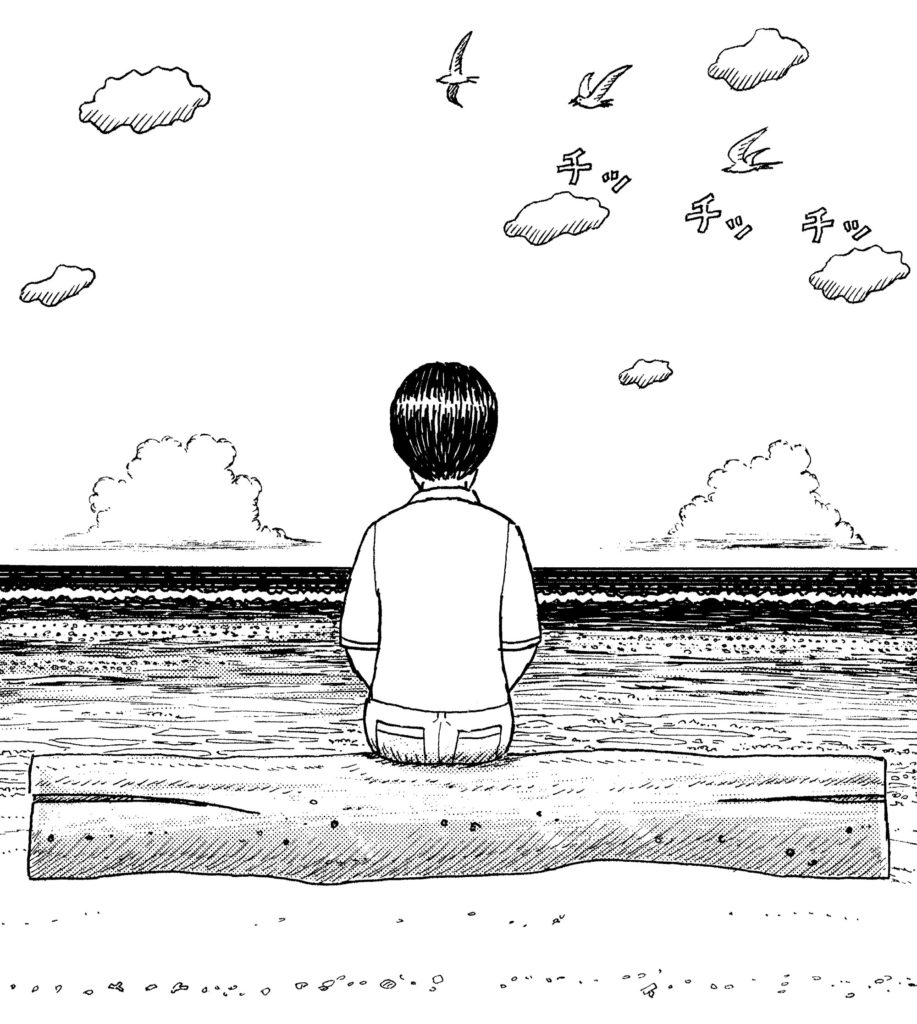
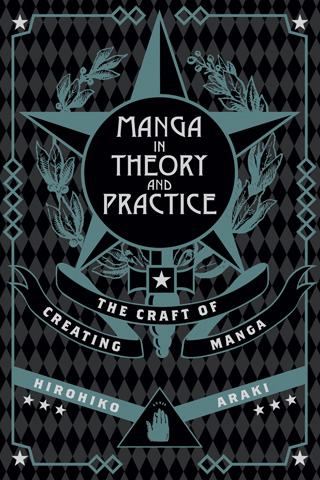
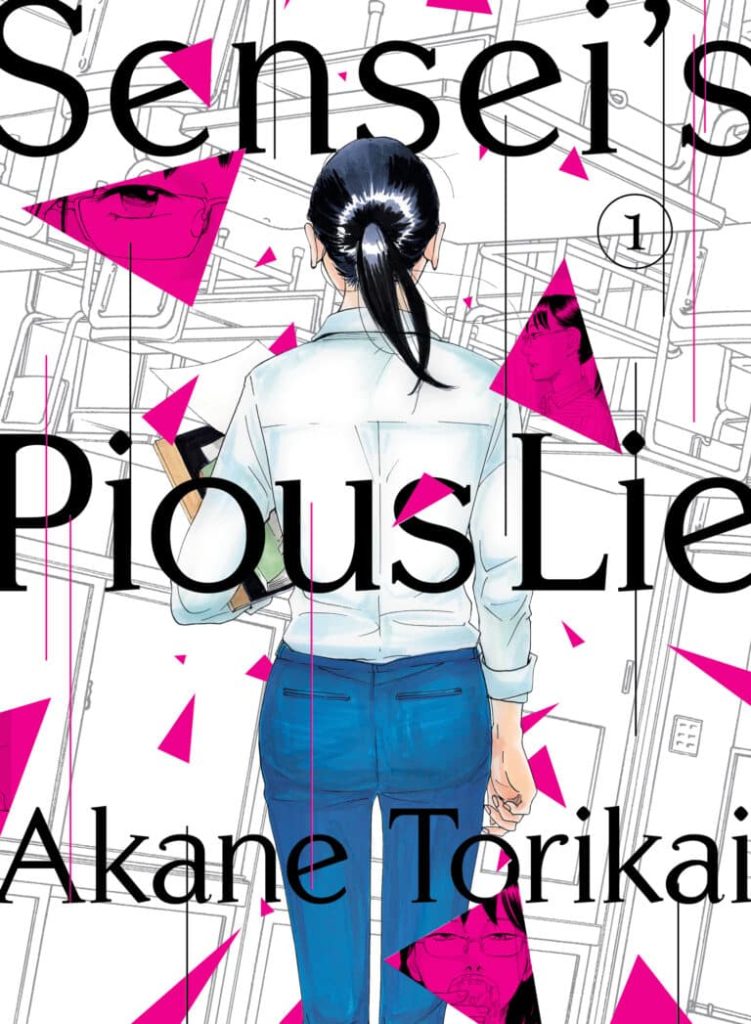
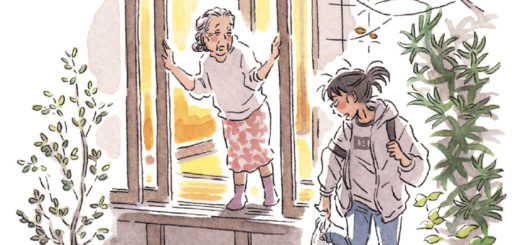
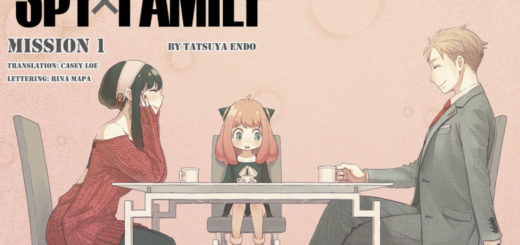
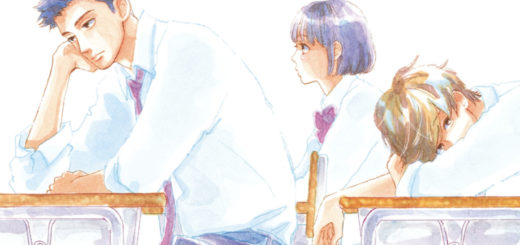
I’ll open my comment with an obnoxious correction to these notes–Hagio’s Iguana Girl is from 1991, which isn’t “just a year or two” before the frame story here. It’s about ten years before. I think you just messed up your dates accidentally, as Yoshinaga wasn’t even published at the time–but yeah, Iguana Girl was so highly regarded among the shoujo community (according to books I’ve read about Hagio), I have no doubt that Yoshinaga knew it, whether it was an influence or not is another question. It’s a pretty universal experience, as you all mention a lot of the book is, I think (one I’ve seen in my own family).
I’m curious why int he podcast intro you call it a josei/seinen work? I’m too obsessed with manga classifications–and whether they mean anything or not–but it entirely ran in Melody (I even have several of the issues). But as I rambled in last week’s notes, Melody is an odd duck. All the manga I know from it is so so so quintessentially josei, yet for reasons I can’t understand (and I’ve asked Japanese friends about this who find it odd, too) it has always been marketed as a shoujo magazine. But this isn’t a ParaKiss situation where either point could be debated, even if Hakusensha wants to call the magazine it comes from as shoujo, I think it would be damn hard to call Darling Daughters anything but josei.
(And as to recommending other Yoshinaga titles, I’m with Chris that it’s too bad that her long run series have translation problems–especially the bizarre artistic choice made for Ooku–but I think both are strong enough that you can get past the translations. But I’m an uber fan, so what do I know.)
But yah, great episode (sorry, yes, this is another long one–listening to the podcast brought up even more thoughts about the manga…). And I loved that it brought out so many personal stories—I think it’s that kind of book, that in some ways makes you reflect on your own experiences even while reading it, just as much as getting involved in the story itself. I hadn’t re-read this since it came out, even though Yoshinaga is a fave of mine. When her mostly smutty BL (excepting non BL Flower of Life) came out, I lapped each one up. At the time, they were some of the few BL titles in English that felt like they had any substance.
But as Chris (I think) mentioned, Darling Daughters seemed to mark a turning point for Yoshinaga. Her earlier work often had crazy pacing issues and tonal shifts that never quite worked (I’m looking at you, Ichigenme vol 2) or out there plots where you could see what she was trying to do, but never quite landed (the lonely gay serial killer in Truly Kindly, anyone?), whereas here, I really feel like everything just works.
When Daughters came out, I admit I think I felt a bit betrayed that it didn’t even have *one* gay character in it and that maybe Yoshinaga, now that she hit it big, would ditch any BL element, but we know that proved to not be remotely true (though she did ditch the smut, and even in her smuttier spin-off doujinshi Chris mentions, they aren’t *remotely* as kinky as her 90s stuff was. Maybe she’s just matured more than I have.)
To the various points made in the episode… Yeah, sure, the framing device can be seen as lazy, with new characters dropping in so we find out their story, but I found it actually made it really satisfyingly cohesive. And sometimes there was subtlety there—like in the story of the friend who never realized her friend was being abused which Yukiko wanting to reconnect with them and writing them about her marriage, for purely self-absorbed reasons as well—she also doesn’t recognize the abuse (even in her memory as depicted, we see the girl with a garish bandage over her eye that no one seems to ask about).
One thing that struck me on this re-read… Whenever I read reviews of Daughters, they focus entirely on how well it handles the complex relationships between mothers and daughters. And it does. But I haven’t seen
any discussion about the ways father figures have affected the women as well. Notably father figures who are actually absent from the direct narrative–never shown, except through photographs or “voice over” memories. You have a father who died when Yukiko is 12, which aggravates the difficulties with her relationship with her mom. You have one father who is sexually and physically abusive–something apparently the mother turns a blind eye towards. And you have a grandfather whose well intentioned imparting of his life philosophy on his grand daughter ends up (in my reading of it, anyway) crippling her from being able to live her own, self-focused life.
And this is where I really read chapter 3 differently from you all, and from how I read it twelve years back. Sayako is told by her grandfather at a young age that she mustn’t discriminate among people. Apparently *at all*. Even people who are jerks to her, her reply is “He’s too good for me”. If she discriminates by focusing her love, her good etiquette, etc, on just one person, she isn’t being fair to everyone. While I agree that she’s not shown as a doormat, and, like so much of this manga, it’s ambiguous, when I read it this time, it made me feel that by idolizing her grandfather and taking his words to heart, she lost some sense of self worth. If a creep sets up a meeting under false pretenses because he thinks it’s a way to have sex, you should be allowed to at least say “Well he was a creep”.
It’s absolutely a variation of chapter 2’s blow job story where the student thinks she’s not worthy of being anything more than at the service to other (men)–and in that chilling scene at the end of that chapter, we see a classmate insult her, and immediately that character shows that she’s now interested in him. OK, of course it’s at a different level, but the final image of Sayako as a nun is damn ambiguous (I swear I won’t use that word again) to me—check out her expression. Is it meant to be an expression of finally being at peace and finding her calling? Maybe, but I don’t think so. And really, are we meant to think being a nun means not discriminating among people? OK, I won’t press that point because Yoshinaga doesn’t either, but it’s not like there was any sense of her being religious or having a calling before.
If anything it seems like, because she was unable to discriminate and so would never choose a husband (and, so, at least for most Japanese women especially 20 years back, stop being a burden living with her parents the way her divorced sister is) being a nun was the only solution. The only place she could go where she wouldn’t be in a world where you DO have to discriminate to, well, get through life.
Yeah, yeah, it’s a cynical take, but having read basically every other Yoshinaga work available, I strongly think it could be the one Yoshinaga wanted. Or at least wanted that question to be there.
(Oh, and like David said, I *loved* the booing in chapter two during the blowjob story. And terrific recommendations for Western comics that relate to this work which, much to my shock, are all books I’ve read…)
Thanks for the comment, Eric! And for the correction–yeah I totally got muddled on the dates, I will adjust. On re-reading the book again for the show-notes after we recorded this episode, I started to maybe twig to what Yoshinaga was trying to say about the grandfather in the third story. I don’t think it’s explicit, or even just one thing, and I’m not entirely sure what the message is there even now. Other than, as you said, showing that when you’re young a parental figure can have an outsized affect on people. Good catch on the connections between the second and third stories too. As for Josei/Seinen–something about my research for this episode caused me to write that, but damned if I can remember what it was now. 🙂
The quote from Araki ([in superhero comics] “panels are laid out with the most importance placed on good drawing composition, and the sketches focus on the characters’ actions”), your discussion, and how Chip said this mostly applied to “the lower to mid level artists,” made me think about one major way in which the American and Japanese comics industries differ (and which you’ve discussed before) that undoubtedly affects this: art sales.
If I remember correctly, you said in a previous episode that the majority of mangaka keep all of their art and don’t sell it. I think this leads to considerably different thoughts on what “needs” to be drawn versus superhero art (when drawn on paper*), which is almost always sold and used as a way for artists (presumably especially “lower to mid level artists”) to supplement their income.
Basically, it’s a lot easier to sell a page featuring Spider-Man punching the Rhino than a page of Peter Parker developing photographs when you’re not a “name” artist. I could be wrong but I feel that this leads to the expectation not just from the reader that every issue will have a fight, but also from the artists, for whom a percentage of their income depends on those fights. Does that make sense? Maybe?
* I do wonder how artists working digitally affects this.
Also, I’m a different Matthew than the one that asked this question!
Despite this manga eliciting a gamut of reactions from our hosts, a number of which were on the negative side, this episode still got me thinking about maga, comics, in art in a way I haven’t in a good while. Not that other episodes haven’t, but I had to pause this one a couple of times to reckon with my thoughts on a few things. As always, Eric comes into the comments with an entirely different perspective from our hosts that got me thinking about things again.
I was not expecting that question regarding Araki’s thoughts on Western comics. I’m so glad you didn’t give it short shrift, because there’s a lot there. I think as our hosts and Matthew in the comments pointed out, it’s not as simple as that, and the way comics are created and published, including their divergent histories, affects how the creators execute the storytelling. Heck, you can even seen a difference in execution between creators who work on 2000 A.D., a weekly anthology comic, versus monthly comics in North America. Chip’s comment about mid-level artists…WHEW! Harsh but fair. Christopher mentioned this in the show notes, but it’s rare to see Western comics breathe, you know? It’s a shame when the manga influence hit North American comics artists, the only thing they took was big eyes and speed lines, and not that great storytelling you get in the facial expressions.